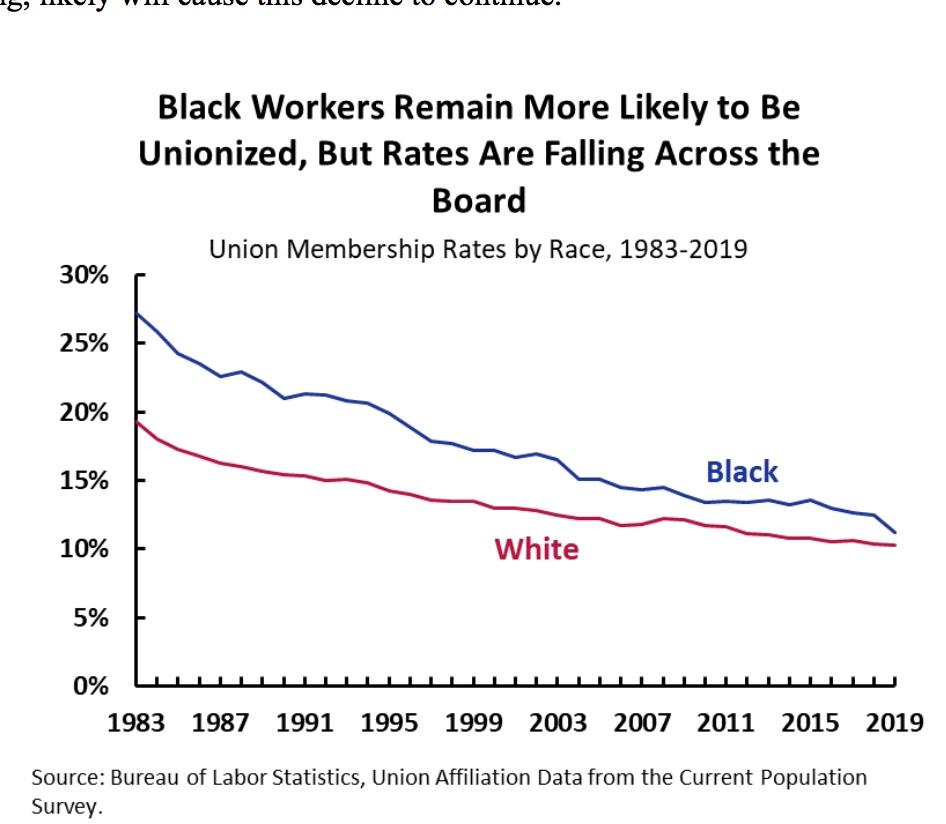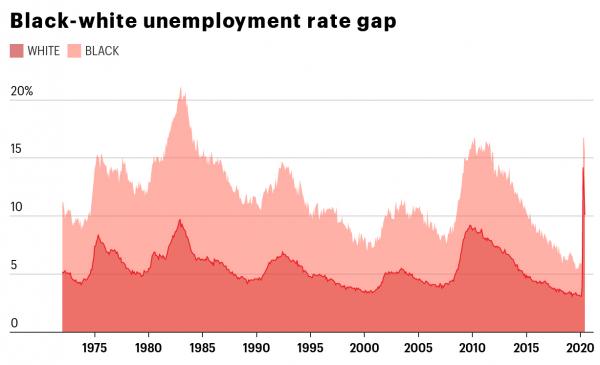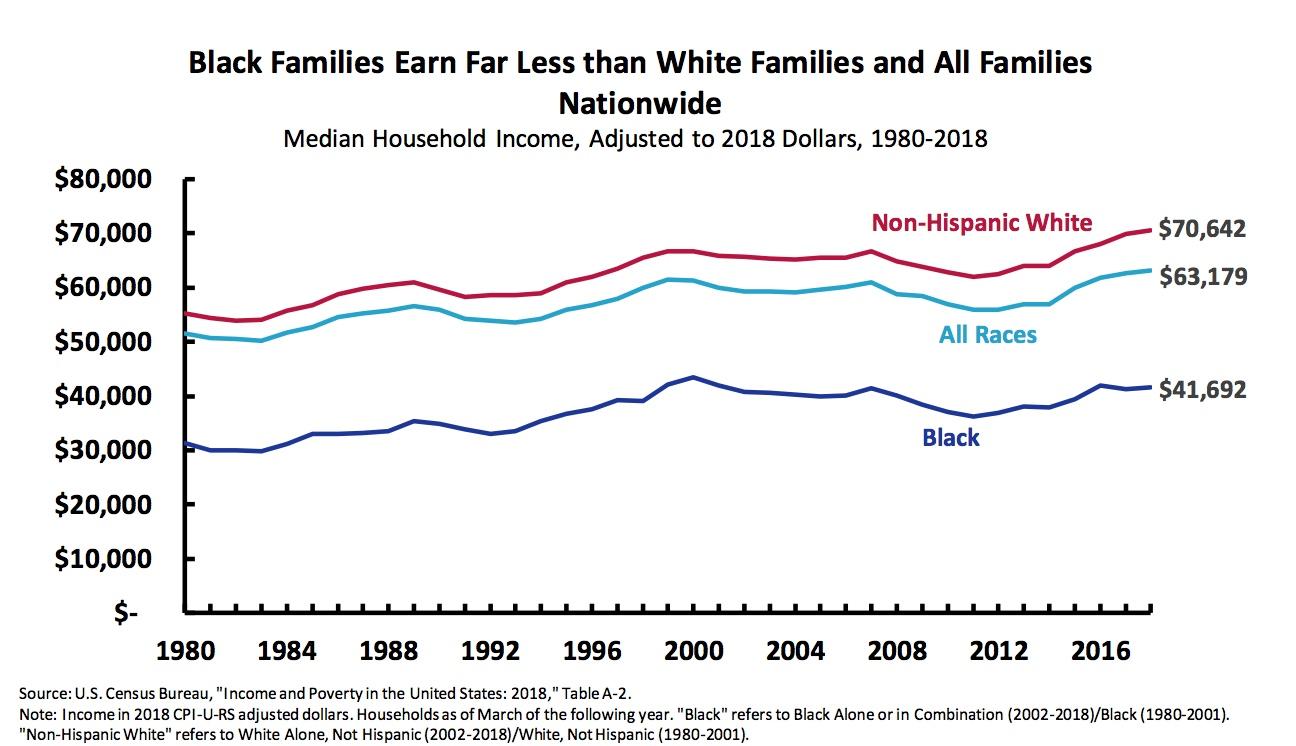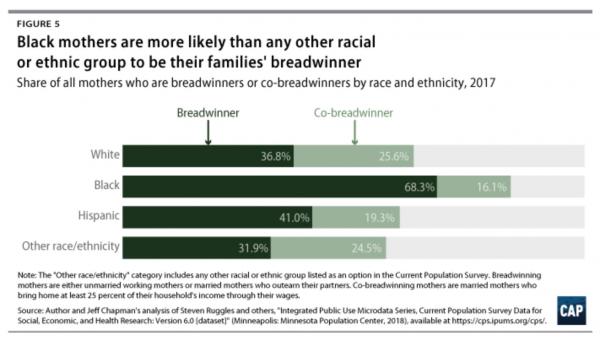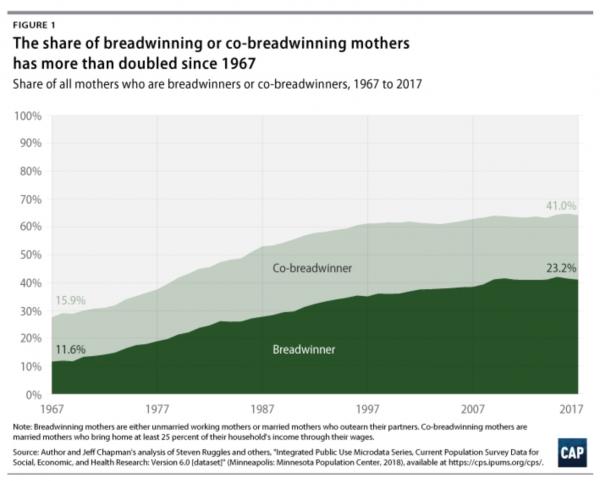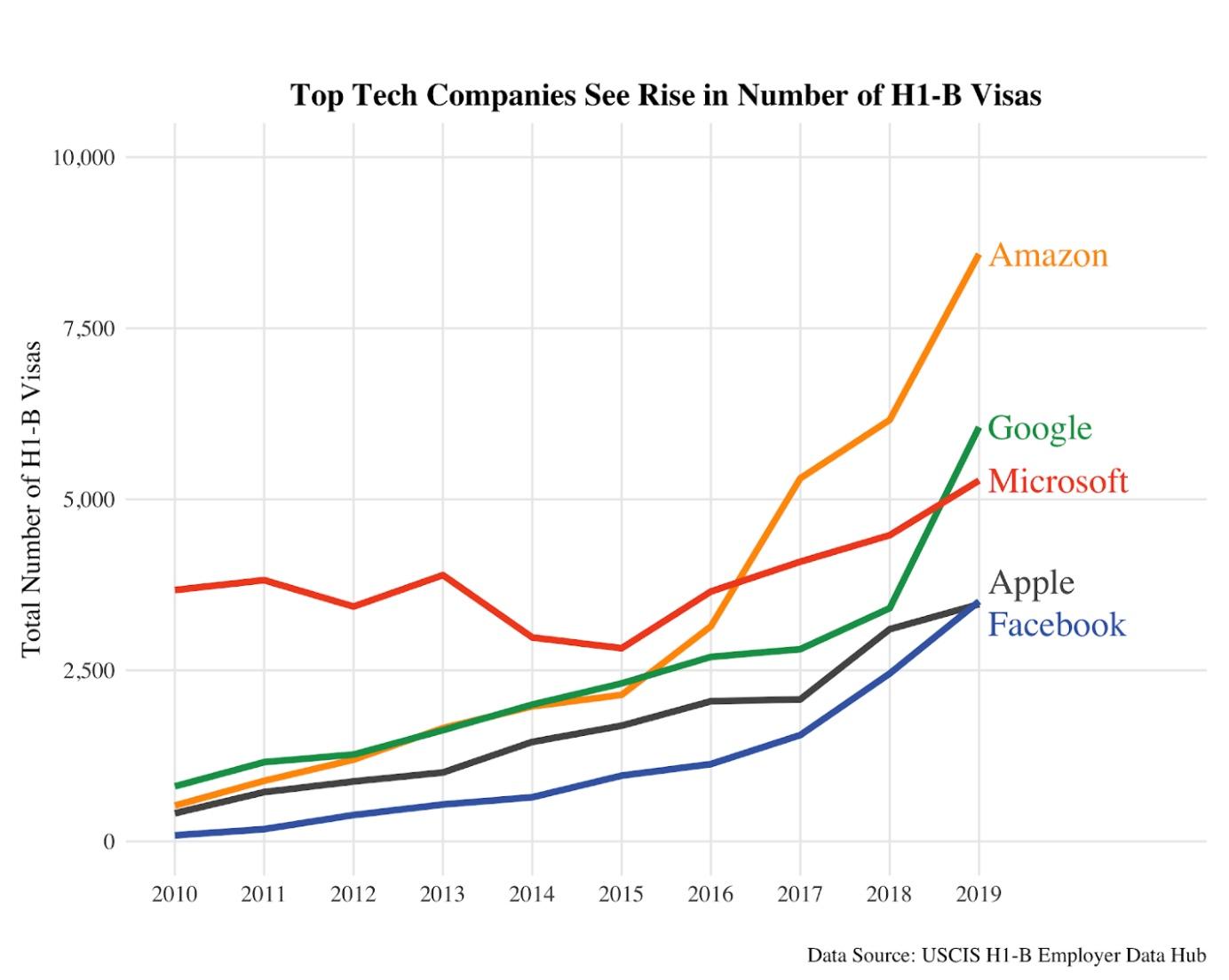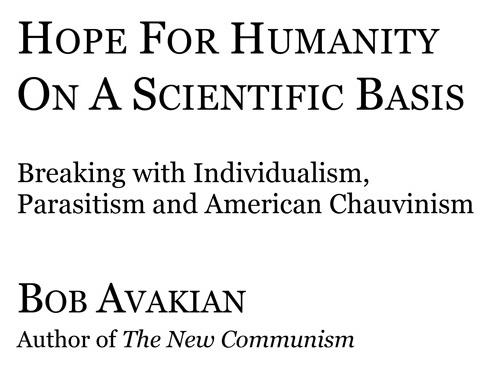Download and print (PDF) of this article:
In Breakthroughs—The Historic Breakthrough by Marx, and the Further Breakthrough with the New Communism, Bob Avakian writes of an increasingly globalized capitalism that:
relies to a very great degree for production and for maintaining the rate of profit on a vast network of sweatshops, particularly in the oppressed countries of Asia, Latin America, the Middle East, and Africa (the Third World or global South), while capitalist activity in the capitalist-imperialist “home countries” is increasingly in the realm of finance and financial speculation, and the “high end” of (not the physical production of the basic physical materials for) high tech, as well as the service sector and the commercial sphere (including the growing role of online marketing). As Lenin phrased it, this puts “the seal of parasitism” on the whole of societies such as the U.S...
In relation to that “seal of parasitism,” Bob Avakian posed two intertwined questions for research and grappling: How definite and operative is the connection between heightened globalization and intensification of exploitation by imperialism, in particular U.S. imperialism, in the oppressed countries of the Third World, on the one hand, and the changing social and class composition of the United States, on the other? Can these changes be understood as a defining expression of imperialist parasitism?
The answer to these two questions is that there is in fact a very strong connection and, yes, the social-class changes that have taken place in the U.S. over the last few decades are very much a defining expression of imperialist parasitism.
What follows are key findings and synthesis of investigation. A brief Summation of major themes of this paper is available at revcom.us.
INTRODUCTION: ON THE SIGNIFICANCE OF PARASITISM AND U.S. SOCIETY
To understand why we are confronted with the situation we are, it is necessary not merely to respond to—and in effect be whipped around by—what is happening on the surface at any given time, but to dig beneath the surface, to discover the underlying mainsprings and causes of things, and arrive at an understanding of the fundamental problem and the actual solution.
—NEW YEAR’S STATEMENT BY BOB AVAKIAN
Parasitism is a concept that V.I. Lenin, the great communist theorist and leader of the Russian Revolution of 1917, worked with extensively in his analyses of imperialism—the system that dominates the world. Parasitism refers to the ways in which the imperialist countries benefit from the superexploitation of labor—horrific conditions of employment in which workers are paid at bare subsistence or below-subsistence levels—in the oppressed countries of Asia, Latin America, and Africa (the Third World or global South). This provides a critical source of profits and stimulus to the profitability of capital.
The subjugation of the oppressed countries by imperialism not only distorts their economies and societies—such as the ways in which imperialist agribusiness devastates subsistence agriculture (food grown on small, family-based landholdings to meet basic survival needs) and drives people from rural areas into ever-swelling cities. This subjugation also “reacts back” on the entire social structure of the imperialist countries. The profits, or “spoils,” of empire enable the imperialists to maintain a certain, relative social stability in the heartlands of empire in normal times. Parasitism results in the greater concentration of wealth among bourgeois-financial strata whose economic activity is ever more divorced from the realm of production.
This research paper is divided into nine sections organized around these themes:
- Setting the stage: heightened imperialist globalization, shifts in the global labor force, and superexploitation in the Third World
- Imperialist globalization and financialization of the U.S. economy
- Massive decline of manufacturing employment in the U.S. economy... but not its disappearance; the attack on and decline of unions
- More on changes in the occupational structure and growing inequality in the U.S.
- When work disappears, the pain is great... but far greater for Black workers than for Trump’s “neglected” white worker; broader employment and unemployment trends, especially for Black people
- A changing economy and women’s struggle for equality: shifting gender norms colliding with patriarchy and its brutal reassertion
- Foreign-born workers in the U.S., and the “brain drain” from the Global South
- Not a “disappearing” middle class... but a reconfigured middle class whose traditional core has been “hollowed out”
- Growing regional divergence in the U.S. and growing inequalities
The character of employment and the typical family household in the U.S. are very different today than in 1970 or 1980:
- A profound transformation of the occupational structure (the types of jobs that people get) has occurred over the last 50 years. The U.S. economy is now overwhelmingly dominated by jobs in services—medical-health, other professions, information, finance, technical, government—as opposed to production. There has been a steep decline in manufacturing employment. The single largest occupational category in the U.S. is retail.
- Big demographic changes in the labor force, especially involving women and immigrants, have taken place. At the start of 2020, women were the majority (slightly over 50 percent) of employees in the U.S. economy; and immigrants from the Third World are essential to profitable functioning of key segments of the U.S. economy.
- There has been an ongoing disintegration of the traditional patriarchal household (married couple-family with children and a sole, male breadwinner). This is connected both with these economic changes, especially the decline of better-paying manufacturing jobs and resulting financial pressures on families, and with the struggles of women for equality and access to work and career, along with other social changes.
- The post-World War 2 working class based in large-scale industry, with union protections, has shrunk massively in the U.S. as a proportion of the labor force—though there are still millions of industrial-manufacturing workers. This was happening as corporations relocated operations to low-wage countries to meet intensified competition and to maximize profits and introduced new job-displacing technology in efforts to raise efficiency and competitiveness.
- The post-World War 2 “American middle class” of better paid workers who could achieve a “middle-class standard of living” and small proprietors has become less defining of the contemporary U.S. middle class. An upper middle class of professionals (“credentialed” with four-year college and advanced graduate degrees) and financial-administrative-technical strata has gained far greater economic and social weight and influence.
Different factors have conditioned the shifts that have taken place in the class-social configuration of “late imperial” America. These include geopolitics, like the great power rivalry, including the “space race,” between the U.S. and Soviet Union... and the eventual demise of the Soviet Union and its imperialist bloc in 1989-91, which gave the U.S. greater maneuvering room internationally. The necessity of U.S. imperialism to maintain, enforce, and extend its empire has called forth military spending and investments in technology and computerization that spread through the economy. There is the impact of political and social struggles, especially those of Black people and women—and how they have influenced patterns of employment (like the expansion of government jobs for women and Black people).
But the most decisive factor at work—not by itself but interpenetrating with these and other factors—has been deeper imperialist penetration into the Third World, and the fuller integration of the oppressed economies into the world capitalist economy. The defeat of the socialist revolution and the restoration of capitalism in China in 1976 was a critical development: the new rulers of China opened the floodgates to foreign capital investment and China became the epicenter of a massive new wave of imperialist globalization in the global South.
Imperialist parasitism—superexploitation of the labor forces of the oppressed countries and plunder of raw materials—and fierce competition among the imperialist powers for markets has contributed to growing occupational polarization. The U.S. economy requires engineers, “money managers,” and information technology workers. It also needs low-paid cashiers, hospital orderlies, logistics and delivery workers, and low-paid food processing workers.
The economic transformations of the last few decades... the dramatic turns of the economy, most notably the “great recession” of 2007-09... and the economic disruptions and widespread suffering related to the 2020-21 COVID-19 pandemic as it has unfolded within the structures and constraints of world capitalism... these major developments have NOT led to a “great leveling” within the U.S.
This underscores an important feature of U.S. society:
Imperialist globalization has contributed to an increasingly fractured, polarized, and “enclaved” society—not only racially but also in terms of different social groups. U.S. society is marked by extreme deprivation on the bottom... income and employment gains for professional-technical strata... and the obscene, grotesque redistribution and concentration of wealth towards a small upper fraction of society.
For anyone yearning for a radically different and far better world, it is important to gain a scientific understanding of the nature and scope of the social-class changes that have taken place in U.S. society since 1970: their material roots and political-ideological manifestations. This is deeply shaping people’s lives. It is part of the ground on which fascism in the U.S. has grown and taken hold. These trends and changes have profound implications for socialist-communist revolution in this era—for being able to identify its bedrock and broader forces and for being able to recognize and act on the potential for and obstacles to making that revolution.
Not least, it is this highly parasitic society that a truly radical, liberatory revolution must transform... as part of advancing the world revolution to emancipate all of humanity. In this light, Bob Avakian's New Year's Statement: A New Year, The Urgent Need For A Radically New World—For The Emancipation of Humanity is essential reading—to understand the dynamics that have led to the dire situation that humanity is now confronting and why revolution, guided by the new communism that Avakian has developed, is the only real alternative to this system of capitalism-imperialism with all its horrors.
This research paper is divided into nine sections organized around these themes:
- Setting the stage: heightened imperialist globalization, shifts in the global labor force, and superexploitation in the Third World
- Imperialist globalization and financialization of the U.S. economy
- Massive decline of manufacturing employment in the U.S. economy... but not its disappearance; the attack on and decline of unions
- More on changes in the occupational structure and growing inequality in the U.S.
- When work disappears, the pain is great... but far greater for Black workers than for Trump’s “neglected” white worker; broader employment and unemployment trends, especially for Black people
- A changing economy and women’s struggle for equality: shifting gender norms colliding with patriarchy and its brutal reassertion
- Foreign-born workers in the U.S., and the “brain drain” from the Global South
- Not a “disappearing” middle class... but a reconfigured middle class whose traditional core has been “hollowed out”
- Growing regional divergence in the U.S. and growing inequalities
I. SETTING THE STAGE: HEIGHTENED IMPERIALIST GLOBALIZATION, SHIFTS IN THE GLOBAL LABOR FORCE, AND SUPEREXPLOITATION IN THE THIRD WORLD
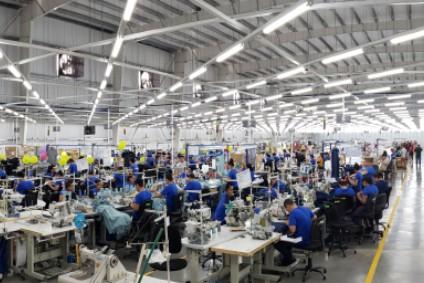
Between 1970 and 2012, the share of Third World countries in the total amount of worldwide exports of manufactured goods rose from 20% to 60%. Photo: Tegra
The heightened imperialist globalization of production refers to the fact that a qualitatively greater share of industrial production serving the profit-making requirements of imperialist capital is carried out in wider parts of the world, outside the “home” (the domestic) market of the imperialist economies—even though the national-home market remains the single largest market and is the base of the national-imperialist capital of countries like the U.S., Japan, Germany, Russia, etc. This heightened globalization is an expression of the expand-or-die logic of capitalism-imperialism and the rivalry among imperial powers. Imperialist globalization involves the growth of manufacturing capacity (factories and equipment) and related transport, power generation, and communications in the oppressed countries of the Third World. It involves the integration of production activities worldwide under the dominance of imperialism.
In particular, a greater share of manufacturing—whether we’re talking about the production of automotive equipment, clothing, appliances, and so forth—is carried out overseas by imperialist firms in the Third World. This is done through direct foreign investments, as when a General Motors sets up factories, distribution centers, etc. Or investment takes the form of “outsourcing,” as when a Walmart, Target, or Apple contracts out production to local firms in Asia, Latin America, and Africa. In all these cases, needed elements for production (like components required for Best Buy TVs produced by local companies in China) may be subcontracted out to yet other local suppliers.
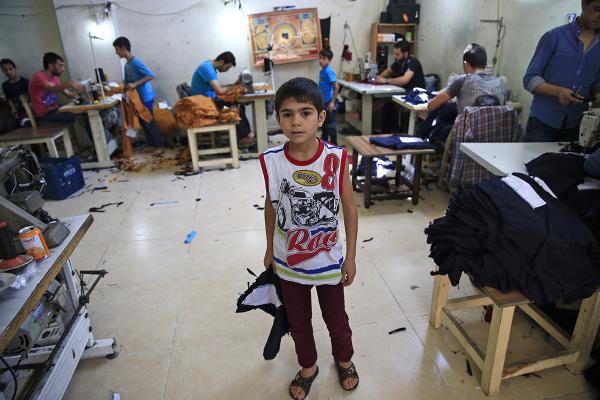
Syrian refugees, including children, sew and haul bundles of clothes in subcontracted workshops in Turkey. Photo: AP
► Some 30-35 percent of all exports leaving the U.S. and some 30-35 percent of all the imports entering the U.S. are actually goods that are being transferred within U.S. transnational companies (like General Motors, General Electric, Boeing, etc.) that straddle the globe. For instance, some 40 percent of the value of goods that the U.S. imports from Mexico is actually part of a loop-like process in which, to take an example, automotive parts manufactured in the U.S. might be shipped to Mexico for assembly, and then exported back to the same companies in the U.S. Boeing encourages its U.S. domestic suppliers of equipment to outsource to Mexico.
This lowers costs for U.S. capital. It cheapens the cost of parts and supplies. It cheapens overall labor costs. Again, taking the case of Mexico, in 2016 average hourly manufacturing compensation costs (wages and benefits received by workers) in Mexico was $3.91; in the U.S. it was $39.03—in other words, workers in Mexico were receiving 1/10th the pay of U.S. workers in manufacturing.1 All this enhances profitability and is essential to bolstering the competitiveness of U.S. capital on the world market.
► A large percentage of the world’s clothing, appliances, and other consumer goods—and a growing share of the components and equipment, and other elements that enter into the production of more advanced manufactured goods in the imperialist countries—are being produced in the countries of the global South. Between 1970 and 2012, the share of Third World countries in the total amount of worldwide exports of manufactured goods rose from 20 percent to 60 percent.
Before 1980 the great bulk of manufactured goods that developed capitalist and imperialist countries imported into their economies came from other advanced capitalist countries. But this has also changed: the share of imported manufactured goods of advanced capitalist countries coming from Third World countries rose from 10 percent in 1970 to 57 percent in 2012.2
The imperialist world economy is marked by a situation where the process of production (increasingly carried out in the Third World) and the final consumption of goods (focused in the rich imperialist countries) are increasingly disconnected from each other. This is a major expression of modern-day imperialist parasitism.
Let’s look at some examples:
—If your shirt or iPhone could talk...
In 1990, 56 percent of all clothes purchased in the U.S. were made in the U.S. By 2012, only 2 percent of these clothes were produced in the U.S. Most of the workers producing these garments and textiles are employed in the poor countries of the global South. Most are women, some are boys and girls. Fewer than 2 percent of workers in garment and textiles earn a “living wage.” In 2016, Western clothing giants like H&M, Next, and Esprit were found to have Syrian refugee children sewing and hauling bundles of clothes in subcontracted workshops in Turkey. The World Bank has calculated that in the global garment industry, the wage cost per clothing item produced is only 1 to 3 percent of the final selling price!3
As the 2010s opened, most of Apple’s iPhones were assembled in a factory compound in China run by the Taiwanese-based company Foxconn. Employing 450,000 workers, this was the largest agglomeration of factory workers in the world. These workers were subjected to a relentless pace of work, and cruel systems of control, including public humiliation and punishment for speaking. It was outside the gates of this factory complex in 2010 that assembly line workers threw themselves off the roofs of towering 10- and 12-story dorms where many live—killing themselves in protest against such conditions.4 Note that Amazon, Microsoft, and Sony also outsource production to Foxconn.
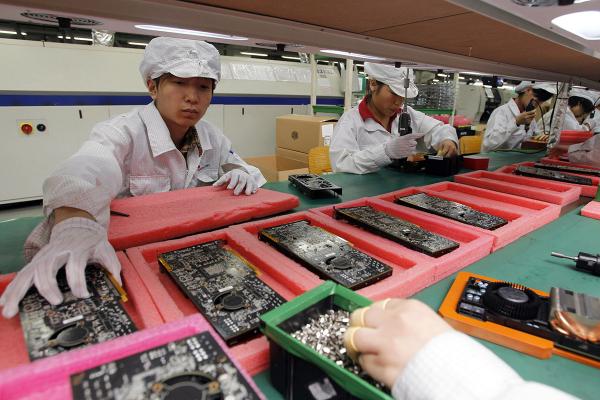
Most Apple iPhones were assembled at this Foxconn factory in southern China. Foxconn employed 450,000 workers. Photo: AP
—Pharmaceuticals and medical
The U.S. controls the dominant share of the highly profitable global pharmaceuticals market. It benefits more than any other imperialist country from the use of “intellectual property rights” (patents for new drugs that keep prices high and unaffordable for great numbers of people in the oppressed countries and that, for extended periods, prevent cheaper, generic versions from being produced). At the same time, 80 percent of the ingredients going into many of these patented drugs sold in the U.S. are manufactured abroad. China is the largest overseas supplier of compounds that go into drugs. And 40-50 percent of the generic drugs consumed in the U.S. are manufactured in India.5
Or take the case of personal protective equipment. A product essential for protecting the lives of medical personnel who save lives is produced in imperialism’s supply-chain sweatshops that endanger lives. Consider the conditions at the Malaysian company Top Glove. It supplies 25 percent of the global rubber glove market.
This is a company that has been sued for forced labor. Its workers live in dormitories, 20 to a single room, producing up to 220 million disposable gloves a day, with workers earning some $300 a month. With facemasks “soaked in sweat,” they work week after week of overtime, with no social distancing, and never receiving the results of COVID tests they are required to take. Of the 11,215 employees, 5,700 in a single complex have tested positive since November. A whistleblower who warned of the unsafe conditions and dangers was promptly fired.6
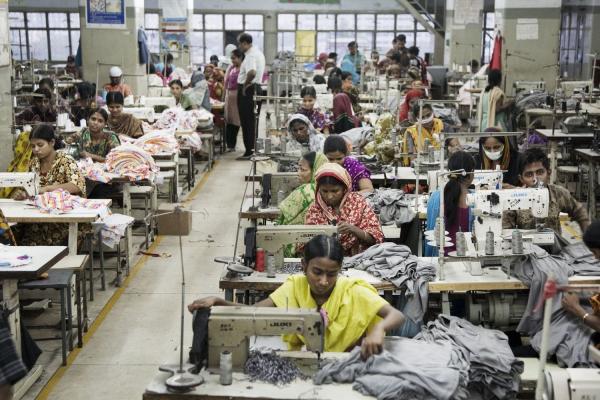
The workers at Top Glove factory in Malaysia live in dormitories, 20 to a single room, produce 220 million disposable gloves a day for “roughly $300 a month in salary.” This is a case of how a product essential for protecting the lives of medical personnel who save lives is produced in sweatshops that endanger lives. Photo: AP
► Pulling the lens back... supply chains and the competitive struggle for imperialist profitability.
These are the workings of “supply chains” that began to take hold from the 1970s onward. A supply chain is an integrated network of production units, transport, and distribution forming the process of producing a final commodity for sale: from clothing, to automobiles, to pharmaceuticals, to electronics, and jet engines. Imperialist capital contracts out to different suppliers that are links in interrelated segments of production. Supply chains encompass mining of materials, manufacture of parts and components, assembly of products, and transportation.
Supply chains (sometimes called “value” or “commodity” chains) constitute what some scholars call the “new central nervous system” of the world (imperialist) economy. By the 2010s, 80 percent of global trade was flowing through supply chains dominated and controlled by Western transnational corporations. One in five jobs worldwide is linked to production in these chains.7
Low-cost production in the oppressed countries is pivotal to the profitability of these supply chains.
Now the same factory in China might be producing goods for different Western corporations. But supply chains are not some single monolith serving a single “super-imperialist” capital. They are privately controlled by competing corporations, banking, and investor groups. They are weapons in the competitive battle of imperialist capital for winning market share. The imperialist corporations that command these supply chains, that purchase the output from low-cost suppliers, put continual pressure on suppliers to further cheapen costs, and move operations from, let’s say, Indonesia to Vietnam. And as imperialist rivalry intensifies, supply chains are geographically reconfigured to lower costs, to minimize disruptions, and build up new or strengthen existing bases of competitive strength. This has been a phenomenon of the 2020-21 pandemic, as trade tensions between the U.S. and China grew.
Imperialist supply chains combine 21st century high-tech global coordination of production and transport with 19th century sweatshop conditions in the oppressed countries, as in the garment factories of Bangladesh that employ 3.6 million workers, many of whom live in mud-drenched slums. Low-cost suppliers in Honduras, in China, in Vietnam, and elsewhere are competing with other suppliers to meet production targets and standards set by a company like Target. If that means factories with no grounded wire or fire exits... if it means makeshift buildings that collapse, only to be replaced quickly by others—so be it. That is the cost-cutting logic of capital and profit maximization.
Think about it: Apple, the iconic emblem of so-called “American ingenuity” and “technological prowess,” would not be the U.S’s first $2 trillion company (a record ignominiously achieved during the COVID pandemic) without the 40,000 children who dig tunnels and haul rocks from cobalt mines in the Democratic Republic of Congo—providing a mineral essential to gas turbines and jet engines as well as to powering smartphones, laptops, electric cars, and other “devices of our times.”8
Imperialist supply chains combine 21st century high-tech global coordination of production and transport with 19th century sweatshop conditions in the oppressed countries.
► Under the dominance of imperialist capital, a globally integrated, cheap-labor manufacturing economy has been forged. The numbers below show how the global industrial workforce is increasingly concentrated in the oppressed countries of the global South.
—1950: 34 percent of the world’s industrial workers lived in the global South
—1980: 53 percent of the world’s industrial workers lived in the global South
—2010: 79 percent of the world’s industrial workers lived in the global South9
On the one hand, more of the world’s industrial production is carried out and more of the world’s workers are located in the Third World. On the other, the global labor force effectively doubled in size between 1980 and 2000—rising from 1.5 billion workers to 2.9 billion workers.10
A major factor driving the vast enlargement of exploitable labor available to imperialist capital beginning in the 1980s was the defeat of the Chinese socialist revolution and restoration of capitalism in China in 1976. As imperialist globalization intensified through the 1980s and 1990s, a now-capitalist China was incorporated into the world imperialist economy—with Chinese sweatshops and low-cost factories integrated into global supply chains. For the last 20 years, China has been the second largest recipient of foreign investment, and the superexploitation of Chinese labor became a vital stimulus to imperialist profitability.*
Put differently: there would be no “Walmart price” without the “China price”... based on savage exploitation. And keep in mind that Walmart is the largest retailer in the world (bigger than Amazon) and that 70 percent of Walmart’s merchandise is manufactured by workers in some 30,000 factories in China.11
In this period of the 1980s and 1990s, India was also being more fully integrated into the world imperialist economy. By 2008, China accounted for 43 percent of all global supply chain jobs, followed by India with 16 percent of all global supply chain jobs. For both countries, the main destination for the goods they produced and sold on the world market was the U.S.12

40,000 children dig tunnels and haul rocks from cobalt mines in the Democratic Republic of Congo. Cobalt is an essential mineral for the lithium-ion batteries used in electric vehicles, laptops and smart phones. Photo: AP
► The vast growth of a global pool of labor—much of which is cheaply employed, under-employed (part time or temporary), and unemployed—puts downward pressure on wages worldwide, including in the U.S.
How is this so? Accelerating in the 1980s, U.S. corporations were relocating more and more manufacturing jobs out of the U.S. to low-wage countries (and similar processes were at work in Western Europe). In those low-wage countries, an abundance of labor—people whose traditional rural livelihoods had been ruined... people flooding into the cities owing to poverty, war, violence, and ecological calamity... people desperate for work—this has created favorable conditions for superexploitation. The fact that more of what is manufactured in the world is produced by laborers in the oppressed countries subjected to cruel working conditions and low pay and the threat of “outsourcing” more jobs—this exerts downward pressure on average wages in the imperialist countries.
► At the same time, the vast increase of imported consumer goods based on highly productive, low-wage (intensely exploited) labor in the Third World has contributed to sustaining mass consumer purchasing power in the U.S. (and other imperialist countries). Low-cost production abroad has also contributed to lowering the cost of hiring workers in the imperialist countries.
How is this so? Less skilled workers in the U.S. can be paid low wages and still hold on to a certain level of consumption, even as wages have been stagnant and even as people struggle to scrape by—for instance, by holding more than one job. This is because low-cost production in the oppressed countries has enabled prices of certain consumer goods to fall, like clothing and electronics. So the cost of a flat-screen TV, which is standard in the vast majority of households in the U.S., has come down—and this means that the amount of labor time that the average wage-earning worker in the U.S. must expend in order to buy that TV has also come down.

People whose traditional livelihood was ruined from poverty, war, violence, and/or ecological calamity flee to cities. This has created favorable conditions for superexploitation. Here, some of the 3.5 million who have left oppressive conditions in Myanmar. Photo: UNCHR
An important point of understanding: the imperialist world economy is marked by a situation where the process of production (increasingly carried out in the Third World) and the final consumption of goods (focused in the rich imperialist countries) are increasingly disconnected from each other. This is a major expression of modern-day imperialist parasitism.
II. IMPERIALIST GLOBALIZATION AND FINANCIALIZATION OF THE U.S. ECONOMY

Financialization refers to the greatly increasing importance and weight of banking-financial activity, investment in stocks and management of financial funds, the growth of new and ever-more speculative kinds of financial instruments (where there is great risk of loss but also expectation of great gain); and the general rise of financial profits in the overall economy.
Heightened globalization of production, with China at the epicenter of low-cost manufacturing production, has also gone hand in hand with heightened financialization in the rich imperialist countries, with the U.S. at the epicenter of this process.
Financialization refers to the greatly increased importance and weight of banking-financial activity, investment in stocks and management of financial funds, the growth of new and ever more speculative kinds of financial instruments (where there is great risk of loss but also expectation of great gain); and the general rise of financial profits in the overall economy.
► In the early 1990s, Finance, Insurance and Real Estate (FIRE for short) surpassed manufacturing as the single largest sector of the U.S. economy.13
The extraordinary growth and size of this FIRE sector is measured by its share of “output,” or the “value added” of its activity: like providing “financial services,” deriving fees for “managing risk,” facilitating buyouts and mergers of corporations, arranging “initial public offerings” of sale of stock of new companies poised to grab market share, and profiting from wild run-ups in “value” of stocks and exploiting momentary “price differences” between currencies (the euro, dollar, yen, etc.), profiting from “appreciation” (rising market worth) of commercial real estate, etc.
The purpose of the quotation marks (“ ”) in the above paragraph is to call attention to the fact that this financial activity is not producing real new value in the economy. But these FIRE profits do not come out of thin air. They ultimately rest on real production, on a base of globalized production, on a feeding chain of global exploitation and superexploitation from which imperialist capital and financial institutions extract profits.
Here is a useful characterization (put in somewhat technical terms) of some of the mechanisms at work:
“Extremely high rates of exploitation rooted in low wages in the export-oriented periphery [the oppressed countries of the global South producing raw materials, parts, and finished goods for sale on the world market] have given rise to global surpluses [earnings from selling exports] that can nowhere be profitably absorbed within production [in these less-developed countries]. The exports of such economies are dependent on the consumption of wealthy economies, particularly the United States.... At the same time, the vast export surpluses generated in these ‘emerging’ export economies are attracted to the ... capital markets of the global North, where such global surpluses serve to reinforce the financialization of the accumulation process.”14
Let’s put this parasitism and the larger workings of imperialism and the suffering it causes in more graphic terms:
The toil and agony of superexploited labor in the hellholes of China’s export-processing zones in the 1990s and 2000s was providing U.S. companies with low-cost manufactured finished goods and parts and supplies, and huge profits... while also generating dollar earnings for these Chinese manufacturers exporting goods and other investors... who then exchange these dollars with the Chinese Central Bank... which invests these dollars in bonds issued by the U.S. Treasury. This inflow of funds into the U.S.—rooted in sweatshop labor—helped finance U.S. government spending and stimulated the U.S. economy in the early 2000s.
This inflow of funds also fed a speculative housing bubble (remember the term FIRE—finance, insurance, and real estate)... a housing bubble that later morphed into the subprime mortgage crisis... a mortgage crisis that triggered the global financial crisis of 2008-09... that led to people losing homes and savings in the U.S.... and to the drying up of much imperialist bank lending to many poor Third World countries, leading to cuts in already minimal health spending in these countries... and more unnecessary suffering.

The U.S. dollar is the main currency in the world: for conducting trade; for borrowing funds and repaying debt (when governments in the Third World borrow money, they must export goods to earn dollars with which to pay back what they owe imperialist banks and governments).
► The parasitism of the U.S. economy is facilitated and buttressed by the “privileged” role of the dollar in international finance and trade. What does that mean? The U.S. dollar is the main currency in the world: for conducting trade (oil, for instance, is priced in dollars); for much of global bank lending and repayment of debt (when governments in the Third World borrow money, they must export goods to earn dollars with which to pay back what they owe imperialist banks and governments). The dollar and U.S. market also serve as a “safe haven” for overseas banks, corporations, large private investor institutions, and governments. They invest in U.S. property and financial markets to protect holdings against political and economic instability elsewhere in the world. This “special role” of the dollar gives the U.S. competitive leverage in the world economy; and enables the U.S. government to run up huge deficits in ways that other countries cannot.
Financialization is not just a characteristic of the banking sector per se; it encompasses the increasingly financialized operations of companies like GE and GM (for instance, trading in global financial and currency markets; establishing financial lending arms). At the same time, on the financial sector side, companies like Master Card and Visa are “high-tech innovators” in artificial intelligence and digital commerce.
In cities like New York and Los Angeles, employment in the FIRE sector is large. In New York City, one of every 12 workers is employed in finance and insurance alone.15 This sector generates demand for all kinds of services, for information technology, for communications infrastructure. Investment in U.S. commercial and luxury real estate, sports arenas, high-end shopping districts, and profit-driven gentrification of ever larger tracts of U.S. cities has had a huge impact on the urban landscape of “late imperial America.”
The financial sector contains a high concentration of high-income earners. This has contributed to greater social inequality and social polarization in U.S. society: the enclave-like existence of different segments of the population manifested in housing, access to health care, schooling, and higher education.

The financial sector contains a high concentration of high-income earners. This has contributed to greater social inequality and social polarization in U.S. society: the enclave-like existence of different segments of the population manifested in housing [gated community shown here], also is reflected in access to health care, schooling and higher education.
The heightened financialization of the U.S. economy is at once a product of and essential to the profitable functioning of an ever-more globalized world capitalism—in which imperialist capital and the imperialist countries benefit (siphoning value) from globalized, cheap-labor production networks. From the standpoint of how a consciously planned, socialist economy serving social need would function, this is cruel and absurd. From the standpoint of the requirements of this system of competitive, profit-based, globalized capitalism-imperialism... it is preeminently rational.
A NOTE ON THE OBSCENE CONCENTRATION OF WEALTH IN A WORLD DOMINATED BY CAPITALISM-IMPERIALISM
In 2019, some 2,150 billionaires in the world, with the U.S. leading the pack, had more wealth than the 4.6 billion people who make up 60 percent of the planet! This is parasitism writ large. (Oxfam, Time to Care: Unpaid and underpaid care work and the global inequality crisis, Oxford: 2020)
III. MASSIVE DECLINE OF MANUFACTURING EMPLOYMENT IN THE U.S. ECONOMY... BUT NOT ITS DISAPPEARANCE; THE ATTACK ON AND DECLINE OF UNIONS

Closed auto plant in Detroit.
► Manufacturing employment as a share of total U.S. employment declined from 28 percent of all employed workers in 1960 to 8 percent in 2017. In terms of the actual numbers of workers, manufacturing employment fell from a peak of 19 million workers in 1978 to 12.4 million in 2017, a decline of one-third.16 Between 2001 and 2016, about 18,000 factories closed their doors in the U.S.17
For the 25 years following the end of World War 2 in 1945, the U.S. enjoyed unmatched global economic supremacy and limited competition from other imperialist powers. But that changed in the early 1970s, with the growing economic strength of Japanese and German imperialism. In the 1980s, in particular, large numbers of manufacturing jobs in consumer electronics, automobiles, machine tools, steel, and microelectronics were lost to Japanese competition. Companies like Toyota made huge inroads into markets that U.S. companies had previously dominated, including the U.S. market. This competition was a spur to the kinds of intensified globalization of production discussed earlier—direct investment overseas, outsourcing. And the development of global supply chains has been essential in the battle for global market share.
► In 2010, China overtook the U.S. as the world’s largest manufacturer. Today the U.S. is the world’s second largest manufacturer, and Japan is the third.
The imperialist globalization of production, in particular the shift of manufacturing to oppressed countries, is not the only reason for the decline in manufacturing employment in the U.S. and other imperialist countries.
► Automation and technological change is the other decisive—actually, the main—factor that has contributed to the decline of manufacturing jobs in the U.S. Automation involves machines replacing human labor, like robotics. From 1997 to 2016, real manufacturing output (the goods actually produced) in the U.S. rose 40 percent while manufacturing employment fell some 30 percent. That is a staggering statistic.18
New technologies have led to increased productivity of labor: fewer workers producing more goods. Technological innovation and transformation, and the resulting rise in productivity and shrinkage of the better-paid manufacturing labor force, have been driven by the competitive capitalist need to raise efficiency, in order to preserve and extend market share and profits.

Warehouse employees have to get used to working with robots called “drives” that move goods through delivery-fulfillment centers. Robots speed up productivity and bring down costs. Keeping pace with this artificial intelligence technology is taking a toll on human workers' health, safety and morale. Photo: Amazon-YouTube-screencapture
► That drive for efficiency and cost-cutting to maximize profits also called forth new corporate strategies of workplace reorganization. Intensifying international competition, particularly coming from Japanese imperialism in the 1980s, spurred new management practices like “lean production” and “downsizing”: eliminating jobs considered wasteful or that could be combined with others, making greater use of part-time and temporary labor, keeping inventories of products and materials at flexible levels in order to respond to volatile changes in global demand. The 1990s saw greater use of new monitoring (and surveillance) technologies to intensify the pace of work. These new modes of workplace organization put a premium on fewer workers producing greater output.

The 1990s saw greater use of new monitoring (and surveillance) technologies to intensify the pace of work. These new modes of workplace organization put a premium on fewer workers producing greater output.
► In the U.S. economy today, the largest segments of manufacturing, measured by sales revenues, include sectors like computer and electronic products; motor vehicles and parts; aerospace; machinery; refined petroleum products (fuels for transport, industry, etc., petrochemicals that go into plastics, fertilizers, etc.); pharmaceuticals. The U.S. is now the world’s largest oil producer (“achieved” during the Obama years). It is the leading manufacturer of commercial jets and dominates other aspects of aerospace. Measured by employment, auto and auto parts is the largest single sector of U.S. manufacturing, with some 1 million jobs in 2019.
In looking at that category of “computer products,” keep in mind that Apple is classified as a “manufacturing company” in this sector. But while the iPhone is, as the label says, “designed in California,” the product is almost in its entirety manufactured abroad in low-wage countries, mainly China.
Manufacturing in the U.S. demands, and has seen a shift towards, a labor force with a higher “skill set” and “educational attainment” than was the case 40 years ago. At the same time, and as supply chains operate within the U.S., there are low-paid, less-skilled tiers of workers producing parts and components, along with low-paid sectors like food processing. Temporary workers, most of whom receive lower wages than full-time workers, make up about 10 percent of the U.S. manufacturing labor force.
► The five largest manufacturing regions in the U.S. in terms of numbers of workers are, in this order: 1) Los Angeles Metropolitan area; 2) Chicago Metropolitan area; 3) Dallas-Fort Worth Metropolitan area; 4) Houston Metropolitan area; 5) Detroit Metropolitan area. The Los Angeles manufacturing hub encompasses the high-tech, aerospace sector of better-paid workers, and auto. It also includes the labor-intensive garment industry, which relies heavily on immigrant (and undocumented immigrant) workers—and other sectors, like electronic instruments, medical equipment and supplies.19

The U.S. is the leading manufacturer of commercial jets and dominates other aspects of aerospace. But Boeing has cut production of commercial jets in an effort to reduce costs as orders have slowed. Boeing plant in Renton, Washington, 2013. Photo: Courtesy of Boeing
► The assault on unions by government and industry has been integral to “workplace reorganization” in the manufacturing sector and broader economy. In 1980, one in five workers was unionized (much of this in mining, manufacturing, and transport). In 2019, only one in 10 U.S. workers was represented by unions, a record low since the end of World War 2.
An historical turning/tipping point came in 1981, when then-president Ronald Reagan moved to crush a national strike by air traffic controllers. In the decades since, two things have been happening: a concerted attack on unions by companies and the growth of jobs that were not the traditional object of mass union drives. In the 1970s there were, on average, some 300 large strikes—involving at least 1,000 workers—every year. Through the 1990s that number plummeted to fewer than 60 major strikes per year; in the 10 years 2008-2018, the average number of large strikes per year was just 13!
De-unionization has been a major contributing factor to growing wage inequality in the U.S.: the widening gaps in pay between different sections of the labor force. It is estimated that one-third of the growth of wage inequality among men, and a fifth among women, in the years 1973-2007 was due to fewer workers being represented by unions. To clarify what this means: the wages or earnings for significant sections of workers would have been substantially higher if those workers were covered by union contracts, which typically bring higher wages and benefits—and these workers’ wages are falling further behind those of better-paid workers (both union and non-union) and professionals.20
► The steep decline of manufacturing employment as a share of total employment is a stark and defining feature of a changing job mix in the U.S. One consequence is the enormous strain of limited opportunity this puts on young workers without college degrees searching for jobs. It is generally the case that two or even three service jobs can often be required to make up for the loss of income from, or to earn the equivalent of, one decent-paying manufacturing job.
A NOTE ON FASCIST LIES ABOUT THE LOSS OF MANUFACTURING JOBS.
The discussion of the decline of manufacturing jobs would not be complete without an explicit, scientific retort to Donald Trump’s racist-fascist narrative that Mexican, Chinese, or other workers from Third World countries are “stealing jobs” from American workers. This has no empirical foundation:
—First off, many of those “lost” U.S. manufacturing jobs ”are “forever gone” to technology—like farm jobs that no longer, and will no longer, exist. In fact, as discussed, automation has been the main driver of job loss over these past 50 years.
—Second, workers in the global South are subjected to the same global cost-cutting dynamics of competitive capitalist accumulation and resulting job loss and relocation: jobs moving from Mexico to China, from China to Indonesia, Vietnam, Cambodia... from China back to Mexico. This is not workers from one country “stealing” jobs but capital “racing to the bottom” of wage scales.
—Finally, nobody “owns” their wage job. The capitalist class owns and controls the major means of production, and laborers must, in order to survive, sell their labor power to the capitalist. That private capitalist control over the means of production and the overall conditions of profitability set the terms for workers being hired or let go.
What has changed in the last 30 years is that the exploitable-superexploitable labor force of the world has grown vastly and become more fully integrated into global networks of production commanded by imperialist-monopoly capital. And low-wage/high-productivity labor in the Third World plays a critical role in the production and accumulation of imperialist profit. Which is to say... sections of U.S. industrial workers are thrown on the scrap heap not by foreign workers but by the workings of profit-maximizing capital.
IV. MORE ON THE CHANGING OCCUPATIONAL STRUCTURE AND GROWING INEQUALITY IN THE U.S.

The rapid and chaotic urbanization of the Third World—the expansion of city populations without the corresponding growth of industrial and non-industrial employment and without rational urban planning—is leading to the rise of shanty-towns and slums on a scale not seen before in human history. Here, Mumbai, India, 2020. Photo: AP
► By 1970, the United States completed the transition from a society in which most workers were predominantly engaged in goods-producing sectors of the economy (manufacturing, agriculture, mining) to one in which most were employed in service-producing sectors (like retail, finance, health care, education, etc.).
Dennis Gilbert’s The American Class Structure in an Age of Growing Inequality21 is a valuable reference that offers this overview of how this goods-to-service employment trend has played out in the U.S. over the past four decades, using data from the mid-2010s:
“The post-industrial economy tends towards occupational polarization. It requires engineers, money managers, and physicians, but it also needs cashiers and hospital orderlies. The demand for routine blue-collar and office workers shrinks ... reducing the opportunities for workers without strong educational credentials.... The trend towards earnings inequality is remarkably pervasive. Inequality has increased between the college and high-school educated, between the skilled and unskilled, between younger and older workers, but also between the college educated, among the high-school educated, among doctors, among carpenters, among people employed in manufacturing, among those employed in the service sectors ... even among corporate executives.... The one notable exception to this pattern: the earnings gap between men and women has narrowed. But at the same time, earnings disparities have increased among women and among men.”22
► The largest single occupational category in the U.S., according to the U.S. Bureau of Labor Statistics, is retail salespersons—followed by food preparation/serving workers (including fast food), and then cashiers. Walmart and Amazon are the two largest private employers in the U.S. It is emblematic that Amazon’s immense warehouse (“fulfillment center”) in the Baltimore area occupies the former site of what was once the largest steel-making facility in the world.
► The expansion of what is called “informal” or non-standard work is an important phenomenon of a highly competitive, turbo-charged globalized imperialist world economy. “Informal” employment refers to jobs that are highly insecure: without regular hours (or even set pay); with few if any safety and health protections; and few if any benefits, like unemployment pay or retirement support.
—Despite the growth of manufacturing and other industry in regions of the Third World, almost 70 percent of employment in low- and middle-income regions of the world is in the “informal economy.” This refers to street vendors, food stalls, rag and waste pickers, domestic workers, construction laborers, and others working without regular hours and pay. At the same time, other informal workers fall within far-flung subcontracting arrangements by large firms in industries like toys, footwear, and clothing.23
This is very much linked to the dynamic of the rapid and chaotic urbanization of the Third World: the expansion of city populations without the corresponding growth of industrial and non-industrial employment... and without any kind of rational urban planning and allocation of resources for safe sewage disposal, for educational and health systems for these new migrants to the cities. And so the rise of shantytowns and slums on a scale not seen before in human history.
—In the imperialist countries since the 1980s, and tracking with intensified globalization of production, non-standard employment as a share of total employment has greatly risen. It is estimated by the imperialist think tank Organization of Economic Cooperation and Development that 60 percent of new job offerings in the 1990s and 2000s had these non-standard features of jobs without regular hours and pay and with few benefits. There has been a widening gap between those workers with more “standard” jobs and who have some small, limited measure of job security, on the one hand—and those, on the other, with non-standard jobs. Younger workers are more clustered in these less secure jobs.24
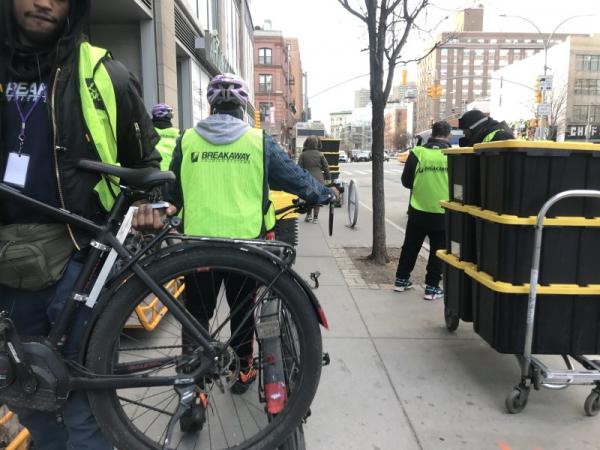
In the U.S., 25-30 percent of the labor force participates in some capacity in what is now called the “gig economy”--and 1 in 10 workers relies on “gig work” as their primary source of income. Here, food delivery workers for Whole Foods. Photo: revcom.us
► In the U.S., 25-30 percent of the labor force participates in some capacity in what is now called the “gig economy”—and 1 in 10 workers relies on “gig work” as their primary source of income. This “gig economy” refers to temporary or freelance jobs, where workers often connect with clients and customers independently and mainly through online platforms.
As throughout the U.S. economy, “gig work” is deeply segmented. Some of this work is high-paying/self-employed in technical/professional/financial services. Much of the “gig work” that goes on is supplementing other work, other jobs, that people might have. This is a new, non-traditional way in which people are working. Some of these “gig economy” jobs are held by the chronically under-employed (people in part-time or temporary jobs wanting to work full time)—and who often rely on this work as their primary livelihood.25
The lower rungs of “just-in-time” logistics workers, including the so-called “last mile” delivery workers for digital commerce, emerged as an important component of the “gig economy” during the COVID-19 pandemic (many Amazon drivers are actually independently contracted and working under great duress).
► The pandemic and occupational inequalities. Access to “safely distanced” work situations is economically and socially polarized. In low-wage sectors with “essential workers,” like meatpacking, workers have long faced extremely hazardous work conditions, including high rates of industrial injury, etc. When the pandemic hit, major meatpacking companies balked at introducing safe-distancing and other protective measures; regular COVID testing was not implemented; and infection rates were high, especially in the early months of the crisis.
In terms of who is able to “telework” (work from home): as the pandemic unfolded, only 9 percent of workers in the lowest 25 percent of wage-salary earners are able to “telework” from home, as compared with over 60 percent of those in the top 25 percent of wage-salary earners.26
► A large sector of low-wage workers is a characteristic of the U.S. labor force: 53 million workers—44 percent of all workers aged 18-64—hold low-wage jobs, with median hourly wages of $10.22 (and annual earnings of about $18,000). Nearly two-thirds of low-wage workers are in their prime working ages of 25 to 54—and 40 percent in this group are raising children.27 Close to half of workers earning less than $15 an hour are employed in what was designated at the start of the pandemic as “essential occupations,” including nurses aides, personal care assistants, and maintenance workers.28
V. WHEN WORK DISAPPEARS, THE PAIN IS GREAT... BUT FAR GREATER FOR BLACK WORKERS THAN FOR TRUMP’S “NEGLECTED WHITE WORKER”; BROADER EMPLOYMENT AND UNEMPLOYMENT TRENDS, ESPECIALLY AFFECTING BLACK PEOPLE
Historically, the manufacturing sector was the source of relatively high-paying jobs to men with high school or less education. The decline of manufacturing has had disruptive effects on the lives of workers of all races and national/ethnic groups—but disproportionately and massively so on Black workers and families.
Some relevant documentation:
► Major job disruption in cities with large Black populations. In Detroit, middle-income Black families depended more on manufacturing jobs than white middle-income families: slightly less than one-third of all Black employed individuals worked for manufacturing companies—a rate almost twice that of white workers, making the loss of these jobs more devastating for Black families. From 1970 through 2013, the number of Black manufacturing, transportation, utilities, and construction workers employed in Detroit fell by nearly half: from 102,000 to 53,000. These workers’ average yearly earnings fell by almost $7,000 in the same period. In Chicago in 1960, one-third of Black workers were employed in manufacturing; in 2017, just 5 percent of Black workers had jobs in that sector.29
► Black workers have historically lagged behind white workers in household wealth. This refers to the value of vehicles owned, home value paid off, retirement savings, stocks, etc. When manufacturing downturns hit, white families had some resources and mobility to leave “de-industrialized communities” and seek out new work prospects. Black families did not have the same capacities, owing to a persistent and worsening “racial wealth gap” (less “household wealth”) and the dynamics of residential housing segregation: being “stuck in place” and not having the same ability to move into neighborhoods of choice because of discriminatory lending practices and other racist institutional barriers. Moreover, in the wake of major plant shutdowns and the overall evaporation of factory jobs, Black workers had considerably less access, and for many no access, to government job-retraining programs.

Flint's poisoned water system is a horrific case study of manufacturing decline, urban fiscal crisis, and unconsionable health endangerment, 2015. Photo: AP
► Flint’s poisoned water system as a horrific case study of manufacturing decline, urban fiscal crisis, and unconscionable health endangerment.
The city of Flint, with a population that is 60 percent Black, lost 70,000 manufacturing jobs—mainly as a result of the decline of auto production from the late 1970s to 2006. The city lost nearly half of its population (with many white people leaving) between 1960 and 2010. The financial stress this put on the city was immense. Because factories shut down, tax revenues fell; as that tax base contracted, it was harder for the city government to borrow money. This put great financial pressure on the city, leading to spending cuts and measures to cut costs.
One such measure was the decision taken in April 2014 to change the city’s water source from treated water from the Detroit Water and Sewage Department from Lake Huron and the Detroit River to water sourced from the contaminated Flint River. Between 6,000 and 12,000 children were exposed to drinking water with high levels of lead—which may lead to cognitive-developmental impairment.30
► Manufacturing job loss and widening Black-white inequalities.
As discussed, historically, the manufacturing sector provided well-paying jobs to less educated men. In the last 50 years, the decline of these types of better-paying jobs has not only had a broad adverse impact on less-educated men in general (including white men) but has also had a larger effect on Blacks relative to whites. In a society and economy in which capitalism and white supremacy are entwined, hardship is not equally distributed. The decline of manufacturing intensified economic and social inequalities between whites and Blacks.
The findings summarized in the study “Torn Apart? The Impact of Manufacturing Employment Decline on Black and White Americans.”31 are revealing.
In terms of effects, the decline of manufacturing employment on the Black community:
- The decline in manufacturing in the 1960-2010 period led to a 13 percent decline in Black male wages.
- This decline accounted for one-third of the increase in wage inequality among Black men (in other words, more income going to higher-paid Black men).
- This decline of manufacturing employment was associated with higher poverty rates for Black women and Black children.
At the same time, there has been a widening difference in the economic and social conditions between Blacks and whites:
- The decline in manufacturing increased the gap in wages between white and Black men.
- The decline in manufacturing also contributed to widening the already substantial gap between Black children living in poverty and white children living in poverty.
- There are similar outcomes over those 50 years in other dimensions as well, like widening gaps in Black home ownership relative to whites, and mortality rates for Black children relative to that of white children.
So the decline in manufacturing employment has put a disproportionate burden on the Black community.
► On African-American employment trends overall. Here is a concise picture as of the mid-2010s:
“Compared with whites, Blacks are still underrepresented at the top of the occupational structure and overrepresented at the bottom, most notably among service workers, which remains, by far, the largest single occupational category for Blacks.... Blacks are still much more likely than whites to have no job at all—especially in periods of recession....
“One result of these trends has been increasing class differentiation among African-Americans. Although large numbers of young, well-educated Black men and women have been moving into jobs that were open to few of their parents, the Black underclass of low-wage or unemployed workers persists.
“The Black-white pay gap, which had long been shrinking, began to expand after 1980. From 1980 to 2016, the median hourly wage of Black men (median is a kind of average) sank from 76 to 69 percent of white men’s. For Black women, who were near parity with white women in 1980, the retreat was even larger: from 90 to 80 percent. (The wages of Black women rose in this period, but white women’s wages rose faster.) In part, these trends reflect larger changes in the American economy, which have especially affected lower levels in the labor market, where Blacks are still disproportionately concentrated: falling employment in manufacturing, the decline of labor unions, the widening wage gap between college educated and less educated workers.”32
The kind of occupational inequality that exists between whites and Blacks (especially the high concentration of Black workers in low-paying service jobs) is captured by this stark statistic: in the U.S. labor force in the mid-2010s, there were approximately 2 health aides for every practicing physician, but 15 African-American health aides for every Black physician.33
► Black unemployment over the last 50 years has, on average, been twice the level of unemployment of white workers. And this official rate does not include individuals who are not actively looking for work.
In fact, a higher proportion of would-be workers among Black people are “discouraged” workers. They have given up the search for work for extended periods, owing to discrimination and lack of jobs in close proximity to neighborhoods. Again, the impact of manufacturing job loss in cities where Blacks have lived and the movement of jobs to suburbs to which lower sections of the Black labor force do not have ready access—often because of lack of convenient public transportation, as well as housing discrimination.
Many “discouraged” workers become “disconnected” from the formal economy.
► Systemic racism and under-employment among Black people. Underemployment refers to the phenomenon that a significant section of the working population is compelled to work part time or in temporary jobs—but really want to be working full time. And so, this grim reality: in 2019, in a pre-pandemic period of economic growth, the Black underemployment rate was 12 percent—that’s 1 out of every 8 Black workers, which is twice the level of underemployment for whites.
► Many African-Americans are working in jobs that do not reflect the skills and educational level they have achieved... they cannot gain employment in their chosen field. And so, this grim reality: in 2019, in a pre-pandemic period of economic growth, almost 40 percent of Black workers with a college degree or advanced (graduate school) degree who were employed... were working in a job that does not require a college degree. To put it differently, they are working in jobs that do not give expression to their skills, creativity, and aspirations.34
In a cruel way, the U.S. prison system acts as a systematic “regulator” of jobs and labor markets for Black and Latino men in particular—steering the formerly incarcerated into low wage jobs and excluding them from better-paying jobs.
► The “crime of mass incarceration” perpetrated against Black people and its consequences for employment. As is well known, the U.S. has the highest incarceration rate in the world. As is well documented, African-Americans are more likely to be incarcerated following an arrest than whites (states imprison Blacks at five times the rate of whites).
The formerly incarcerated have a far more difficult time securing employment than does the general population. Studies show that having a “criminal record” reduces employer callback rates (after a formerly incarcerated person files a job application or interviews for a job) by 50 percent. The jobs that many formerly incarcerated do land tend to be insecure and low-paying. And exactly because of the instability of these jobs, people in and out of these jobs will often leave the labor force altogether, or enter into the “underground economy” of semi-legal work.35
The formerly incarcerated of color return to impoverished neighborhoods of high unemployment (again, the vanishing manufacturing jobs that had once been a staple of local economies). Many with prison “records” are denied full access to public housing, to food stamps, student financial assistance, and job training. They face high barriers to getting certain jobs requiring occupational licenses and apprenticeships (and at the same time go through training and certification programs that lead nowhere). In some of the poorest Black communities, the formerly incarcerated confront a near total absence of or exclusion from regular, gainful employment and the omnipresence of a drug economy.
In a cruel way, the U.S. prison system acts as a systematic “regulator” of jobs and labor markets for Black and Latino men in particular—steering the formerly incarcerated into low wage jobs and excluding them from better-paying jobs.36
* * * *
A NOTE ON SOME CHANGING EMPLOYMENT PATTERNS OF MEN... AND TRUMP’S BASE OF “ANGRY WHITE MALE WORKERS”
► There has been a significant decline in the participation rate of men aged 23-54 in the labor force. In the 1950s and 1960s, 97 percent of men between the ages of 25 and 54 were working or looking for work; in 2018, this was down to 89 percent, and was much lower in distressed manufacturing regions.
► There have been changes in how long people work for one employer—and this has a gender dimension. Since the early 1970s, as manufacturing employment has declined, women have been entering the labor force by the millions. As these women get older, their “job tenure”—this means how long on average they stay with one employer—increases. But for men in certain age categories, job tenure has undergone change. In the 1980s, some 40 percent of men aged 50-59 had been in their current jobs 20 years or more. But by the mid-2010s, this had dropped sharply to 26 percent. This was especially pronounced in manufacturing, but occurred across a wide range of industries, including construction, retail, and agriculture.37
► “Angry white men” finding fascist “voice and vindication” in Trump-ism.
As demonstrated in this analysis, white workers were not hit harder by economic strains and distress of the past 50 years than Black workers. But two things must be noted:
—First, the fabric and expectations of the “longstanding social world” of sections of privileged white male workers have been fraying since the late 1970s—especially since the early 1990s when globalization of production centered in China greatly accelerated. Steady, well-paying, “male-dominated” manufacturing jobs were being lost. The new jobs available were increasingly low-paid service, on the one hand, and those requiring more education on the other. And both categories of jobs have been and are increasingly populated by women and minorities.
—Second, sections of these strata were and remain fired up by a sense of “dispossession as members of the formerly autonomous, independent, lower middle class of independent farmers, small shopkeepers, and skilled workers.”38 The fascist response has been the mobilization of “aggrieved (white) male entitlement”: the cry of being “robbed and emasculated” of a “birthright” by “undeserving others” (fill in the blank). This is very much linked to the dynamics of imperialist globalization, the decline of manufacturing employment, and the erosion of previous conditions of relative stability and some measure of upward social mobility (the ability to climb job ladders and make gains in income). At the same time, there have been dramatic changes in the position and role of women in the economy and society that become grist for the politics of fascist resentment.
VI. A CHANGING ECONOMY AND WOMEN'S STRUGGLE FOR EQUALITY: SHIFTING GENDER NORMS COLLIDING WITH PATRIARCHY AND ITS BRUTAL REASSERTION.

The struggle of women in the 1960s and 1970s for equality undermined traditional work expectations and life trajectories. Photo: Wikimediacommons
The whole question of the position and role of women in society is more and more acutely posing itself in today’s extreme circumstances—this is a powderkeg in the U.S. today.
—Bob Avakian
The dynamics associated with the “post-industrial” transformation of the U.S. economy, resting on ever-more globalized production centered in the Third World, have interacted with the struggle of women in profound ways. This has had major effects both on the representation of women in the labor force and on the traditional patriarchal family (patriarchy referring to the dominant position of men in society and the economy).
The ranks of working women increased markedly in the 1950s and 1960s. This took a further leap in the 50 years since. In 1968, 40 percent of working-age women were participating in the labor force—that is, either holding jobs or looking for jobs; in 2018, 60 percent of working-age women were in the labor force. In January 2020, just before the pandemic hit, women were the majority (just over 50 percent) of employees in the United States.39
► The massive entry of women into the labor force has been driven both by economic necessity and political-social struggle. As “well-paying” manufacturing jobs with benefits were vanishing—and these jobs were predominantly held by males—the wages of the male “breadwinner” (the person whose earnings support a family) could no longer financially support that family.
This economic pressure compelled more married women to seek work. This was simultaneously accompanied by the great expansion of the largely low-paying, female-dominated service economy. Some of the key sectors are retail, health care, and education. Much of that employment, such as in rapidly expanding retail like Walmart, “offered” highly variable work hours at low wages and with few benefits. Growing numbers of married women entered the labor force—preponderantly into these kinds of jobs—and this helped buffer against loss of family income from the decline of male manufacturing employment.
At the same time, the struggle of women in the 1960s and 1970s for equality was undermining traditional work expectations and life trajectories. Occupational barriers were being broken down as married and unmarried women—often using laws like Title VII of the 1964 Civil Rights Act (which prohibits discrimination by employers based on race, color, religion, sex, and national origin)—fought for the opportunity to make employment decisions for themselves and to pursue a career outside the home.
Anti-discrimination and affirmative action measures had a major effect of boosting the employment of women, as well as Black workers, in particular sectors, especially government jobs. For decades, women have made up the majority of the state and local government workforce, and in 2019, women made up 60 percent of all state and local public-sector workers.40
In the last 50 years, work has become a core part of women’s identity, an identity no longer strictly defined and circumscribed as “homemaker” or “support system” for men. But this was/is happening in a male supremacist and white supremacist society.
In the early 2000s, only 1 of 14 households in the U.S. was made up of a married couple with children in which only the husband works.
► Social and cultural changes and the vanishing “traditional family.”
Important social-cultural changes have facilitated women entering into, and being pulled into, the workforce. These include wider availability of contraception and a declining birth rate; a rising divorce rate; and the increasing proportion of births to single women. In the United States today, mothers are the breadwinners in nearly half of families with children under 18. Forty-five percent of white mothers are the breadwinners, 47 percent of Latina mothers, and 74 percent of Black mothers.41
By 1970, the traditional American family of a married couple with children “headed” by a sole male breadwinner (the stuff of old TV shows) was disintegrating. In the early 2000s, only 1 of 14 households in the U.S. was made up of a married couple with children in which only the husband works.42
By 2015, 20 percent of all family households were headed by females—up from 10 percent in 1970. For families with children, over 25 percent are headed by women (in other words, neither a “male breadwinner” nor two-parent incomes). These families experience high levels of poverty.43
► Huge increase of women gaining college degrees and women’s increasing presence in the professions.
As the U.S. expanded higher education in the late 1950s and 1960s (this was strongly linked to the global competition with the Soviet Union), more women began entering and graduating from college and graduate school. This trend accelerated from the 1970s onward. Since 1982, women have earned more bachelor (4-year) degrees than men. At the graduate school level: in 1971 women received just over 10 percent of doctoral degrees, by 2014 it was over 50 percent; in 1970, women made up just over 5 percent of medical school graduates; today some 50 percent of medical school graduates are women.44
► Inequality among women in the labor force
While women of all economic and racial/ethnic groups entered the workforce in greater numbers, this also took place alongside a major divide between professions open to middle-class women with college and graduate degrees and the kinds of work generally available to less-educated women, especially women of color.
Indeed, part of the conditions that made it more “feasible” for professional women to enter higher-paying occupations has been the expansion of services like housecleaning, day care, home health care, and food preparation. These jobs are largely low-paying and overwhelmingly performed by women—and many of the home and care jobs are filled by immigrant women from Mexico, Central America, and the Caribbean, and other parts of the Third World.
At the same time, households headed by women, especially women of color, face enormous financial strain and hardship. These women struggle to support families generally without access to affordable child care and paid family and medical leave.
So there is this “pulling in different directions,” in terms of family income. Married heterosexual couples in which both spouses work in the professions have seen a great increase in their combined family income. And the earnings of wives in these households have been pivotal to the growing share of total income of the top 20 percent of families in the U.S. Meanwhile, the difficult circumstances facing female-headed families with children has put downward pressure on the incomes of those on the lower rungs of society.
Patriarchy continues to place the onus of choosing between “career or family” on women. The unequal, patriarchal division of labor that continues to assert itself—and the lack of social-government policies to support caregivers who also work—means that the norm for working mothers is that they return home to a “second shift” of unpaid housework and caregiving.
“At the end of the day,” even though working parents are the modern norm—women still spend far more time caring for children and performing household labor than men with the same parental and working status. And through the 2020-21 COVID pandemic, great numbers of women have had to leave jobs because of school closures and caregiving responsibilities—and various studies have shown that women are doing significantly more of the additional childcare, education, and housework during the pandemic.45
► Changing economy and gender roles... and men. Men continue to benefit from structural-institutional male privilege in job access, pay, and workplace authority. But there has been a downward trend for sections of male workers compared to the pre-1970 situation, with respect to a) acquisition of skills; b) employment rates; c) occupational “status” (the vanishing of well-paying manufacturing jobs); and d) real wage levels (especially for those without a college education).
As globalization, technological transformation, and the decline of unions accelerated, the economy, as already discussed, was shifting from occupations traditionally dominated by men to more female-dominated, low-paying service jobs, many of which have the “stigma” of “women’s work” attached to them: like caregiving, which is profoundly devalued in this society. (More men are joining some of these jobs, but not at the rate that women are joining male-dominated jobs.)
As the U.S. economy has undergone the economic-social changes described, principally driven by leaps in imperialist globalization, there is this new reality of “late imperial America”: more women at work... more of household income being provided by women, and in growing numbers of households with two wage earners, women earning more than husbands... and more men at home unwilling to take certain jobs, or locked out of work (as is the situation facing currently incarcerated and formerly incarcerated Black and Latino men). This alongside the continuing unraveling of the “traditional” family.
► The massive entry of women into the workforce has not overcome “gender segregation of jobs.” The last 50 years have seen more men and women moving into “non-traditional” occupations: for instance, more women becoming doctors and more men becoming nurses. But the mixing of women and men in occupations slowed down after the 1990s and came to a halt in the 2000s. More than 40 percent of workers are in occupations in which more than 75 percent of workers are of one gender.
One of three working women is employed in two industries: health care and social assistance, and the so-called leisure and hospitality industry (food and beverage, hotels and other lodging, travel, etc.). But even when men and women work in the same occupation—as hairdressers, cosmetologists, nurses, teachers, computer engineers, mechanical engineers, or construction workers—men earn more, on average, than women.
The concentration of women, especially women of color, in the hospitality and service sectors made them particularly vulnerable to the economic disruptions of the pandemic—these were jobs that shut down early. Relative to their pre-pandemic employment levels, Black and Latina women suffered the greatest employment setbacks in the first year of the pandemic relative to any demographic in the labor force.46
Women continue to be under-represented in certain industries and occupations and are paid less than men in all sectors. Today a woman employed full-time, year round, earns about 80 cents for every dollar earned by a similarly employed man. In relation to white non-Hispanic men, white women earn 79 cents, Black women 63 cents, and Latinas just 55 cents.47
► And across all occupations, the plague of sexual harassment
What has been called the “‘manly’ jobs problem” refers to a diminishing set of jobs and an associated workplace culture where being “adept” is defined in aggressive, masculine terms of physical strength. Again, that sense of male entitlement “threatened” both by the contraction of manufacturing employment and by the entry, starting in the 1970s, of women into these jobs (as well as construction and mining). Women perceived as “undeserving” and “unqualified”; women as the objects of the vile and violent reassertion of male hegemony.
The #MeToo outpouring of 2017-2018 against male sexual abuse, harassment, and degradation initially erupted in media companies, technology start-ups, and the entertainment industry. The cancer is pervasive. This is from an account of a 25-year legal battle to redress sexual harassment of women who had worked at a Chicago Ford plant. Many of these women had finally won jobs that paid a living wage. They lifted their heads only to find that:
Bosses and fellow laborers treated them as property or prey. Men crudely commented on their breasts and buttocks; graffiti of penises carved into tables.... They groped women, pressed against them, simulated sex acts.... Supervisors traded better assignments for sex and punished those who refused.
In her last year there [one of the African-American plaintiffs who quit her job at Ford] said she earned $23 an hour; at Bed Bath & Beyond, she got only one-third of that pay. [Since leaving Ford], she worked as a home-health aide at night and mowed lawns during the day.... “I’m 61 years old, and I cut grass for a living.”48
Extensive research shows that women are driven out of non-traditional occupations by hostile work environments. Some 60 percent of women working in science, technology, and engineering jobs experience sexual harassment. Over time some half of women in these occupations quit their jobs—and half of them wind up leaving these fields altogether.49
VII. FOREIGN-BORN WORKERS IN THE U.S. ECONOMY; THE “BRAIN DRAIN” FROM THE GLOBAL SOUTH

In 2015, 150 million migrants, overwhelmingly from the global South, were part of the global labor force. Almost half of these workers are concentrated in two regions: Western Europe and the United States. Migrants from Central America headed north, stop in Chiapas, Mexico. Photo: IOM (International Organization of Migration)
Imperialist globalization has intensified the flow of migrant laborers and immigrant workers from Third World countries to the rich countries.
A migrant worker is a person who migrates from one country (or region) to another to seek employment—but not with the intention of permanently staying in that country. In 2015, 150 million migrants, overwhelmingly from the global South, were part of the global labor force. Almost half of these workers are concentrated in two regions: Western Europe and the United States. The vast majority of these migrants (70 percent) are employed in services, a significant number of them are domestic workers, and 73 percent of all migrant domestic workers are women. Immigrants are those who leave a country to settle permanently somewhere else, and who have the option of returning home.50
All told, the number of people in the world who live outside the country of their birth has risen from 153 million in 1990 to 272 million in 2019.51 Growing numbers of refugees are part of the world’s migrant population—tens of millions who have been forced by circumstances to leave their countries to seek safety and asylum—but who often wind up in impoverished refugee camps and brutal detention centers.
The increasing flows of migrant workers and immigrants to the imperialist countries are bound up with conditions of imperialist domination, plunder, and distorted development in the oppressed countries. Imperialist agribusiness undermining traditional agriculture, with the poverty and dislocation that results; the ruinous long-term effects of U.S.-sponsored wars on the economies of countries like El Salvador and Guatemala; and the destructive effects of global warming on agriculture and rural life.
At the same time, the deepening integration of the economies of the global South into the world imperialist system has spurred the growth of middle class and professional strata in these countries—and the imperialist countries exert a pull on these strata. There is the magnet of better-paying/high-paying, and more secure technical and professional jobs, along with advanced research and hospital facilities, etc., and a relatively more stable political-social environment. So, the rich capitalist countries draw in the down-pressed and the educated-professional middle strata (and take measures to attract highly skilled immigrants).
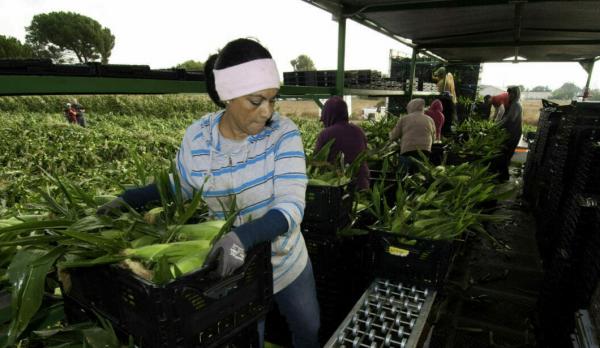
Immigrants and migrant workers make up 17 percent of the U.S. workforce, that's about 1 in 6 workers. 1 out of 3 immigrants in the work force is estimated to be an undocumented immigrant. Because of their precarious status, the 8 million undocumented immigrants in the U.S. labor force are not fully protected by U.S. labor laws. Photo: Courtesy of USDA
A) Immigrants in the U.S. Labor Force
The United States has more immigrants than any other country in the world. As of 2017, some 44 million people living in the U.S. were born in another country. This is a record number in the history of the U.S. Immigrants represent 13.6 percent of the total U.S. population, up from 4.7 percent of the population in 1970—which amounts to an almost a three-fold increase. The 1990s saw a huge increase in the number of immigrants coming into the U.S. The number of adult immigrants coming into the U.S. and the grown children of immigrants is now a major and critical source of the increase in the U.S.’s potential labor force—people who would be working or looking for work.52
► Most of the immigrants in the U.S. come from three countries, in this order: Mexico, China, and India. There are 11 million immigrants from Mexico, compared to some 3 million from China, and 2.6 million from India. So Mexico is far and away the largest source of immigrants in the U.S. This has everything to do with deep poverty in Mexico, intensified by the North American Free Trade Pact (NAFTA) that took effect in 1994, and which opened up more of Mexico’s economy to U.S. imperialist capital. As of the 2010s, the fastest growing segment of immigrants to the U.S. is from Asia.53
► Immigrants and migrant workers make up 17 percent of the U.S. workforce, some 1 in 6 workers—and 1 out of 3 immigrants in the workforce is estimated to be an undocumented immigrant. Immigrants represent 25 percent of all construction workers and 40 percent of all meatpacking workers. And anywhere from 50-75 percent of the field workers who grow, harvest, and process the food that Americans eat are undocumented immigrants, overwhelmingly from Mexico. Undocumented workers make up 25 percent of all maids and cleaners in the U.S.54
Because of their precarious status, the estimated 8 million undocumented immigrants in the U.S. labor force are not fully protected by U.S. labor laws. They are subjected by employers to substandard working conditions and unpaid wages. The sword of deportation hangs over their heads—and the reality and threat of deportation are part of the conditions in which undocumented workers are profitably incorporated as a superexploitable section of the U.S. workforce... living in the shadows.

Imperialist globalization has intensified the flow of migrant laborers and immigrant workers from Third World countries to the rich countries. Migrants from Turkey arrive in Lesbos, Greece, March 2020. Photo: AP
► A defining feature of the relations between the rich capitalist countries and the oppressed countries of the global South is the growing importance of funds that migrant and immigrant workers living and working in the rich countries send home to support their families. While this might amount on average to only 15 percent of these immigrant workers’ earnings in the U.S., this money is often a lifeline for the poor families back home of these immigrant workers—needed cash for basic necessities.
Funds that overseas workers send home are called “remittances.” These financial flows have grown so enormously over the last four decades that their year-to-year amount now exceeds the year-to-year amount of imperialist foreign aid sent to the oppressed countries and imperialist private direct foreign investment (as when Ford opens a factory) in the oppressed countries.55 The exploiting ruling classes of the oppressed countries in turn count on remittances from migrant workers to provide some financial relief towards economic and social stability in conditions of high unemployment and poverty.
Funds sent home by Mexican immigrant workers in the U.S. play an integral role in the current and strategic economic relations of domination by the U.S. over Mexico.
There is a vicious dynamic bound up with the workings of imperialist global expansion. Imperialism’s deepening penetration and anarchic transformation of the oppressed countries drive people from their home countries to the imperialist countries to find jobs. Immigrant workers from Mexico typically work in the lower rungs of the U.S. labor force, where they are subjected to harsh conditions of employment and pay.
Mexico is now the U.S.’s largest trade partner, having replaced China in 2019. As rivalry for global markets with capitalist-imperialist China intensifies, the manufacturing supply chains in Mexico take on magnified importance for U.S. imperialism and global competitiveness. And the remittances sent home by Mexican immigrants working in the U.S. help sustain impoverished households that form part of the reservoir of superexploitable labor serving the profit-maximizing requirements of U.S. imperialist capital.
The number of international students in master’s and doctorate STEM (science, technology, engineering and math) programs now earn more than half of all degrees conferred. Companies sponsoring international technical workers has been integral to the growth of top tech companies. The most well-known way companies hire foreign workers is the H1-B visa, a three-year work visa for a “specialty occupation.” Source: One Zero
B) Imperialist Parasitism and the “Brain Drain” from the Third World to the Imperialist Countries
► High Tech and Foreign-Born Workers
The recruitment of skilled foreign workers from the Third World has played, and continues to play, an essential role in America’s high-tech sector.
High tech refers to those industries and companies with a high concentration of workers in science, technology, engineering, and mathematics. It includes firms in computers, software development, and information technologies; robotics; biotech; and artificial intelligence. It includes companies like Microsoft, Facebook, Apple, Google, Oracle—and new “start-up” companies in these fields. The historical hub of high tech has been Silicon Valley, the area south of San Francisco.
High tech has been a major source of U.S. imperialism’s competitive strength in the world economy. U.S. technological advances today are highly dependent on investment in the high-tech sector, including by Apple, Alphabet-Google, and Microsoft. The supply chains discussed in this paper require sophisticated information, communications, cost-monitoring, and logistics technologies. The genocidal military machine of U.S. imperialism requires this technology. Indeed, there would be no high tech/Silicon Valley absent U.S. government and Pentagon investments, contracts, and funding for science, space, and modern computing.
In this light, think about the following imperio-chauvinist account by former U.S. Secretary of Energy Spencer Abraham regarding the important role of skilled foreign workers in the emergence of Silicon Valley:
“Silicon Valley is a vital catalyst for America’s economic edge. It is the global center of the digital revolution.... The country reaps the economic benefits of having some of the largest and most innovative technology companies and research centers housed within our borders.
“But in the late 1970s, the center of technology revolution wasn’t guaranteed to occur in the US
“At the time, top computer talent was scattered across the globe, and the industry needed a place where the best and brightest could gather to collaborate and innovate. It could have been anywhere—but Silicon Valley ended up in America.
“Why?
“The answer, in large part, is because the US opened its doors to skilled foreign workers.”56
In 1965, the “door opened” with the repeal of the Immigration Act of 1924—facilitating a large inflow of skilled foreign workers, overwhelmingly from the Third World, particularly India. Many were recruited and hired into the burgeoning tech centers of the U.S., notably Silicon Valley. This is a “brain drain” from the poor countries to the rich countries. It is a “subsidy” to imperialism: the cost of training these skilled workers is borne by their home countries. The former U.S. Energy Secretary gleefully recounts that between 1973 and 1977, more than 60 percent of the top electrical engineering graduates from the India Institute of Technology came to the U.S.
The door for skilled workers opened wider in 1990, when the U.S. introduced a special visa (H-1B) that allowed U.S. employers to hire highly skilled foreign workers on a temporary basis. In the mid-2010s, 70 percent of these visas were issued to engineers and other high-tech workers from India.
► Over 70 percent of information technology employees in Silicon Valley in the mid-2010s were foreign born. In Seattle, another high-tech hub, the share of high-tech workers born abroad increased from 11 percent in 1990 to 40 percent in 2016—and more than 40 percent of these tech workers come from India.57
A strategic sector of the U.S. economy thrives on a “brain drain.”
C) “Stealing” Health Care Professionals from the Third World.
In 2015, the number of African-trained medical graduates practicing in the U.S. alone was some 14,000, a 27 percent increase over 2005. This is the equivalent of one African-educated physician migrating to the U.S. each day over those 10 years, 2005-15.
In the mid-2010s, there were more than 247,000 doctors with medical degrees from foreign countries practicing in the United States—accounting for over 1 in 4 doctors in the U.S. Some 23 percent of nursing, psychiatric, and home health aides are foreign-born. One in 10 of such aides comes from the Caribbean and Central America alone!58 There has been a century-long colonial/neo-colonial relationship between the U.S. health care system and medical colleges and nursing schools in the Philippines, which have essentially trained huge numbers of nurses to work in the U.S. And in times of health crisis in the U.S., as with AIDS in the 1980s and 1990s, more nurses from the Philippines are steered to the U.S.
As more graduates of U.S. medical schools go into high-paying specialized medicine, more primary care positions in the U.S. are being filled—more of the basic health care needs of Americans are being met—by physicians and health workers from Third World countries. This exacerbates health care shortages in the Third World. Countries that are major “providers” of doctors to the U.S. and other imperialist countries include India, Nigeria, Pakistan, and South Africa—all countries that suffer shortfalls of physicians.59

The American health care system is highly dependent on professionals born in other countries, an analysis of U.S. census data shows. As of March 2020, there were just over one million professionally active physicians in the United States, and about 1 in 4 are from other countries.
How this plays out in Africa overall is criminal. According to the World Health Organization, Africa has more than 24 percent of the global burden of disease, but has access to only 3 percent of health workers and less than 1 percent of the world’s financial resources spent on health. Africa is in chronic (crisis) need of health care for mothers and their infants. But Africa has experienced an enormous drain of skilled medical professionals to the imperialist countries—to Great Britain and the U.S. in particular.
In 2015, the number of African-trained medical graduates practicing in the U.S. alone was some 14,000, a 27 percent increase over 2005. This is the equivalent of one African-educated physician migrating to the U.S. each day over those 10 years, 2005-15. It is estimated that Africa loses $2 billion annually through the brain drain from the health sector, in terms of the unreimbursed costs of training of medical personnel in African countries who then immigrate to the West, and related losses suffered.60
But the “cost” goes far beyond the ways in which poor countries are financially subsidizing rich countries by providing medical personnel. There is the loss of lives that emigrating physicians could have saved, especially children under the age of five. To put this in stark perspective: at the height of the 2014-16 Ebola outbreak in West Africa, there was an average of 2 doctors per 100,000 in Sierra Leone, and 45 per 100,000 in Nigeria—as compared to some 250 doctors per 100,000 people in the U.S.61
The “brain drain” from the Third World is a savage expression of imperialist parasitism.
VIII. NOT A “DISAPPEARING” MIDDLE CLASS... BUT A RECONFIGURED MIDDLE CLASS WHOSE TRADITIONAL CORE HAS BEEN “HOLLOWED OUT”
Globalization and deindustrialization have not led to a “great leveling.” The U.S. is a far more polarized, fractured, and segmented society than it was in 1970. This is true economically, socially, regionally, and politically.
A certain historical configuration of the U.S. middle class has shrunk. This middle class grew and to some degree thrived economically in the 1945-75 period. It encompassed and was centered on sections of better-paid and unionized workers in large-scale industry, craftsmen, small-business owners, lower managers, salaried public sector workers like teachers, and those in professions not requiring college or advanced degrees.
This middle class was a social base for the “American dream” with its ideological beckoning of material security, the ability of a family to buy a home and “build up some wealth,” and the promise of some upward social mobility (the ability to earn more) for itself and its children. This middle class has seen its conditions deteriorate. There are contradictory effects of the loosening grip of the cohering myth of the American dream. Traditional expectations have been exploded. This is also part of the ground on which Trump fascism feeds.
This decline of the core of the traditional middle class is very much related to what has been analyzed, notably the waves of globalization, technological change, and downsizing of the manufacturing labor force. The auto and steel companies were no longer providing the scale of well-paying, low-skilled jobs that they had in the past, with union agreements offering pensions and benefits. The “big box” stores (Target, Home Depot, etc.) were putting immense cost pressure on small businesses. Teachers have been hard hit since the 1970s—suffering big losses in income as state governments slashed budgets over the last decades. The health care sector remains one of the few in which “middle class-paying” jobs with low- and mid-level skills are being generated.
At the same time, the economic forces working in this direction were also contributing to the growth of an upper end of the U.S. middle class. Concretely, imperialist globalization, technological change, and heightened financialization—and with this the evolution of many U.S. companies like IBM and Dell from production to services over the last few decades—stimulated the expansion of higher-income “domestic supply chain” service jobs. Jobs like operations managers, computer programmers, etc. Their average earnings in the mid-2010s were $63,000. At the higher end of these services—like engineering, design, software publishing, logistics services, etc.—earnings averaged $89,000.
So with the decline of the traditional middle class has come the growth of an upper end of the professional and “new entrepreneurial” petite bourgeoisie. It is found in finance, information technology, biotech, in the legal and medical professions, consulting, and other such sectors. People work as salaried employees and independent contractors, and as business owners. In 1970, 18 percent of the middle class worked in business and professional services; in 2015, 33 percent of the middle class worked in these sectors.
This change in the composition of the middle class has also been a factor contributing to growing inequality in U.S. society. On the one hand, you have the deteriorating situation of the traditional “blue-collar middle class” (those better-paid workers in highly unionized industry who aspired to and achieved a certain middle class lifestyle). In 1971, 28 percent of adults in middle-income households were in manufacturing; in 2015, that figure was 11 percent. On the other, you have the increase in households earning more than $126,000 a year, which in 2015 accounted for 1 in 5 households in the U.S. These households often consist of those highly educated, high-earning married couples in the professions.
So the middle class has declined from an estimated 60 percent of the adult population in the early 1970s to 50 percent or so in 2015, largely because of the decline of its “traditional” core. Meanwhile, an “upper end” of the middle class has grown and made substantial income gains.
To return to a basic understanding of this paper: the expanding upper-end professions exist on the foundation of parasitic globalized production (think Apple) and sit at the higher reaches of the imperialist feeding chain—but those working within these professions are also subject to the work-intensity pressures and squeezes of global competition and profit-maximizing capital.
________
Supplementary Technical Note: The data and income categories in this section are drawn from Sam Fleming and Shawn Donnan, “America’s Middle-Class Meltdown: Core shrinks to half of US homes,” Financial Times, December 9, 2015. They work from the Pew Research Center database. The measure of traditional middle class used is a household having an income that ranges from two-thirds of the median income to two times that income. “Median” is a kind of average income, in which half of wage and salary earners earn more and half earn less. The upper middle class household is one whose income is 2 to 3 times the overall median household income.
IX. GROWING REGIONAL DIVERGENCE IN THE U.S AND GROWING INEQUALITIES
It’s a very marked feature of the society right now...as compared to, say, 50 years ago, [that] this society is much more rigidly divided into different strata and much more enclaved.... [T]here is a widening and hardening of class and social divisions, not just along ‘racial lines,’ or in terms of national oppression, but also more broadly in terms of different social groups in society.
—Bob Avakian
A number of mainstream economists have pointed to a growing divergence (a widening gulf) of incomes among regions in the United States. Some express worry that there is no foreseeable (translation: bourgeois) solution to this and its socially and politically polarizing implications.62
For most of the 20th century, incomes were converging among regions in the United States. But since 1980, incomes have been growing further apart by region. This accelerated in the 1990s—much of this linked with the loss of manufacturing jobs in the U.S. and the rise of capitalist China as the manufacturing center of the world imperialist economy.
The point is, it is not simply that certain sections of the U.S. labor force were hit harder by the loss of jobs and income in consequence of imperialist outsourcing, intensifying global imperialist competition, and technological change. Nor simply that other sections of the labor force have fared far better in terms of jobs and income. It is also the case that these upward and downward trends are more concentrated in certain regions—for instance, heavy manufacturing job losses in the Midwest and the growth of new high-earning middle class professions in the Northeast, Los Angeles and San Francisco, the Pacific Northwest, etc.
The high-earning, so-called “knowledge economy”—employing a highly educated workforce, turning scientific discoveries and research towards profit-making application, and linked with university-research and medical-hospital complexes—is locally clustered in particular cities and in regions (as mentioned above).
Further, the enormous concentration of capital in companies like Amazon, which so thoroughly dominates digital commerce, is another engine of regional inequality—both on the low end of grueling, $10 an hour jobs (Amazon added 425,000 non-seasonal workers during the first 10 months of 2020) and in how it funnels money into wealthier parts of the country, like Seattle and Washington, D.C.63
At the same time, there is increasing regional divergence within states: between coastal cities and cities and towns in the interiors of states.
► In New York in particular but also in San Francisco, Los Angeles, and a few other cities that function as financial-administrative command and control centers of empire, class and social divides are extreme, widening, and hardening. With the growth of wealth on the upper end has come the growth of “wealth work” on the lower end: an expanding category of low-paid “urban servants”—grooming the better-off, stretching them, driving them, delivering for them. Women and immigrants perform much of this work. Many of these workers commute long distances from low-cost neighborhoods to perform this work.
► As we have seen, a growing share of men of prime working age (25-54) are not working or seeking work. Among white men in this category in non-metropolitan areas, the last 20 years saw a rising death rate, especially among 25-44 year olds, due to suicide, opioids, etc. Places such as Kentucky and West Virginia had the same life expectancy as New York as recently as 1990; today they lag five years behind.64
Workers without a college education are still the majority of the U.S. labor force. But today there is very little “upward mobility”—that is, improvement of earnings and incomes over time—for non-college-educated workers. The earnings differentials between non-college-educated and college-educated workers have widened. “Upward mobility” is almost exclusively the preserve of the college-educated—especially so in those regions and cities where high tech, the “knowledge economy,” and finance are concentrated. But as we have also seen, in the racialized and gendered labor markets of U.S. capitalist-imperialism, there is pervasive inequality, including among those with college and advanced degrees.
► Globalization and deindustrialization have not led to a “great leveling.” The U.S. is a far more polarized, fractured, and segmented society than it was in 1970. This is true economically, socially, regionally, and politically.
A crucial insight of Bob Avakian that has helped guide—and that is confirmed through—this analysis: “It’s a very marked feature of the society right now...as compared to, say, 50 years ago, [that] this society is much more rigidly divided into different strata and much more enclaved.... [T]here is a widening and hardening of class and social divisions, not just along ‘racial lines,’ or in terms of national oppression, but also more broadly in terms of different social groups in society.”65
This system crushes and deadens the human spirit as well as grinding away the life—or outright stealing the life—of billions of people in every part of the world.
Think of the tremendous waste—and outright destruction—of human potential that results from all this. All this is the consequence of the fact that the world, and the masses of humanity, are forced to live under the domination of this system of capitalism-imperialism.
All this is the basis on which a relatively small part of the people within this country, and a very small part of humanity as a whole, has the conditions and the “freedom” to develop and apply their initiative and creativity—only to have this serve, under this system, to reinforce the “lopsided,” highly unequal and profoundly oppressive conditions in the world as a whole and for the masses of people in the world.
And all of this is completely unnecessary.
—Bob Avakian
CONCLUSION
At the start of this paper, the question was posed: How definite and operative is the connection between heightened globalization and intensification of exploitation by imperialism, in particular U.S. imperialism, in the oppressed countries of the Third World, on the one hand, and the changing social and class composition of the United States, on the other? Can these changes be understood as a defining expression of imperialist parasitism?
This paper demonstrates that the answer is a definitive yes...
But not in a simple, mechanical way. Heightened globalization is not the only cause of changing social and class composition; nor is there a one-to-one connection between, let’s say, the increase in jobs in global supply chains and the loss of jobs in the U.S. This paper has also shown how the “changing social and class composition in the United States” has been influenced by other important factors, like technological transformation and social struggles. These have interacted with the intensification of exploitation in the oppressed countries of the global South by imperialism.
In understanding trends and changes, it is necessary to recognize the role of contingency as well—that is, major events and shaping circumstances that were not certain to occur and could not have been fully anticipated. Of major importance in this regard was the collapse of the social-imperialist Soviet Union and its bloc in 1989-91, and the defeat of socialism and the restoration of capitalism in Maoist China in 1976. China’s trajectory from 1976 to the present—from a subordinate, capitalist “workshop/sweatshop” for Western imperialism, to a rising imperialist power—has had enormous impacts on and consequences for the world imperialist economy and rivalry among the major imperialist powers.
Imperialist parasitism, of the U.S. in particular, has been heightened through a massive new wave of globalization and deepened penetration of the Third World, especially since 1990. And the changes in the social and class composition in the U.S. over these past 50 years are indeed, in ways illustrated in this paper, a “defining expression of imperialist parasitism.”
Bob Avakian reveals the underlying reality of this capitalist-imperialist system:
This system crushes and deadens the human spirit as well as grinding away the life—or outright stealing the life—of billions of people in every part of the world.
Think of the tremendous waste—and outright destruction—of human potential that results from all this. All this is the consequence of the fact that the world, and the masses of humanity, are forced to live under the domination of this system of capitalism-imperialism.
All this is the basis on which a relatively small part of the people within this country, and a very small part of humanity as a whole, has the conditions and the “freedom” to develop and apply their initiative and creativity—only to have this serve, under this system, to reinforce the “lopsided,” highly unequal and profoundly oppressive conditions in the world as a whole and for the masses of people in the world.
And all of this is completely unnecessary.66
* It is beyond the scope of this paper to analyze the complex dynamics of China’s emergence as a major imperialist power, now contending globally with U.S. imperialism. For the 25 years 1980-2005—and especially through the 1990s when foreign capital flooded in—China principally functioned as a dependent “sweatshop for Western imperialism,” offering up vast labor reserves. Foreign companies were deriving huge gross profits from differences between cost of production and retail price (and a company like Apple has had the additional monopolistic advantages of patented technologies, branding, and retailing). And it is still the case that vast transfers of value are taking place, even as China’s ruling class has built up, and is rapidly accelerating the build-up of, a powerful, independent base of national-imperialist accumulation. [back]
1. Congressional Research Service, U.S. Manufacturing in International Perspective, 2018. [back]
2. Data from John Smith, Imperialism in the Twenty-First Century: Globalization, Super-Exploitation, and Capitalism’s Final Crisis, New York: Monthly Review Press, 2016, p. 53. [back]
3. Data from Dana Thomas, Fashionopolis: The Price of Fast Fashion and the Future of Clothes, New York: Penguin, 2019, Introduction. [back]
4. See Brian Merchant, The One Device: The Secret History of the iPhone, New York: Back Bay, 2018; and Keith A. Spencer, A People’s History of Silicon Valley: How the Tech Industry Exploits Workers, Erodes Privacy, and Undermines Democracy, London: London Publishing, 2018. [back]
5. CNBC, “Fears of US drug shortages grow as India locks down to curb the coronavirus,” March 19, 2020. [back]
6. See “A Company Made P.P.E. for the World, Now Its Workers Have the Virus,” New York Times, December 20, 2020. [back]
7. United Nations Conference on Trade and Development, World Investment Report, 2013; International Labor Organization, World Employment and Social Outlook 2015: The Changing Nature of Jobs, 2015. [back]
8. See “Apple and Google named in US lawsuit over Congolese child cobalt mining deaths,” The Guardian, December 16, 2019. [back]
9. Smith, Imperialism in the Twenty-First Century, p. 100. [back]
10. See the widely cited study by Richard Freeman, The Great Doubling: The Challenge of the New Global Labor Market, New York: The New Press: 2006. [back]
11. Oscar Quine, “Walmart Triples India Exports as Major U.S. Companies Pivot From China,” Newsweek, December 15, 2020. [back]
12. See Intan Suwandi, et al., “Global Commodity Chains and the New Imperialism,” Monthly Review, March 2019. [back]
13. Bureau of Economic Analysis data cited in “America’s Path To A Fire Economy,” Global Macro Monitor, June 5, 2019. [back]
14. John Bellamy Foster and Robert McChesney, The Endless Crisis, New York: Monthly Review Press, 2012, p. 63. [back]
15. “Recent trends in employment and wages in New York City’s finance and insurance sector,” Monthly Labor Review, April 2019. [back]
16. U.S. Bureau of Labor Statistics. [back]
17. Alan S. Brown, “State of American Manufacturing 2019,” American Society of Mechanical Engineers, April 30, 2019. [back]
18. “Most Americans unaware that as U.S. manufacturing jobs have disappeared, output has grown,” Pew Research Center, July 25, 2017. [back]
19. Bureau of Labor Statistics data cited in “What Gets Made in LA Is Way More Than Movies,” National Public Radio, November 30, 2015. [back]
20. Data on unions and strikes from Steven Greenhouse, Beaten Down, Worked Up: The Past, Present, and Future of American Labor, New York: Knopf, 2019. [back]
21. Dennis Gilbert, The American Class Structure in an Age of Growing Inequality, Thousand Oaks, CA.: SAGE Publications, 2018. [back]
22. Gilbert, pp. 251-2. [back]
23. World Bank, “Challenges of Informality,” in Global Economic Prospects, January 2019; and J.J. Thomas, Surviving in the City: The Urban Informal Sector in Latin America, London: Pluto, 1995. [back]
24. See Aaron Benanav, “Automation and the Future of Work,” New Left Review, November-December 2019. [back]
25. See Gig Economy Data Hub, “How many gig workers are there?” and “Who participates in the gig economy?” March 15, 2020. [back]
26. Economic Policy Institute, “Not everybody can work from home: Black and Hispanic workers are much less likely to be able to telework,” March 19, 2020. [back]
27. Martha Ross and Nicole Bateman, Meet the low-wage work force, Brookings Institution, November 2019. [back]
28. “Essential workers comprise about half of all workers in low-paid occupations,” Brookings Institution, November 15, 2020. [back]
29. Data from Center for American Progress, “Trade and Race,” July 18, 2019; The Atlantic, “Chicago’s Awful Divide,” March, 2018. [back]
30. For background, see Anna Clark, The Poisoned City: Flint’s Water, and the American Urban Tragedy, New York: Metropolitan Books, 2018; and Peter Hammer, “The Flint Water Crisis, the Karegnondi Water Authority and Strategic-Structural Racism,” Testimony to the Michigan Civil Rights Commission, July 18, 2016. [back]
31. Eric Gould, VOX, Center for Economic Policy Research, 19 December 2018. [back]
32. Gilbert, p. 58. [back]
33. Gilbert, p. 58. [back]
34. Data from Elise Gould and Valerie Wilson, Black workers face two of the most lethal preexisting conditions for coronavirus—racism and economic inequality, Economic Policy Institute, June 2020. [back]
35. See Lucius Coulotte and Daniel Kopf, Out of Prison & Out of Work: Unemployment among formerly incarcerated people,” Prison Policy Initiative, July 2018. [back]
36. For detailed documentation of ways this plays out in Chicago’s Black neighborhoods, see Jamie Peck and Nik Theodore, “Carceral Chicago: Making the Ex-offender Employability Crisis,” International Journal of Urban and Regional Research, May 2008; see also, Reuben Jonathan Miller, Halfway Home: Race, Punishment, and the Afterlife of Mass Incarceration, New York: Little, Brown, and Company, 2021. [back]
37. Data in this section from Raven Molly, et al., Changing Stability in U.S. Employment Relationships, National Bureau of Economic Research, 2020. [back]
38. Michael Kimmel, Angry White Men: American Masculinity at the End of an Era, New York: Nation Books, 2017, p. 277. [back]
39. Bureau of Labor Statistics; and Tara Law, “Women Are Now the Majority of the U.S. Workforce—But Working Women Still Face Serious Challenges,” Time, January 16, 2020. [back]
40. David Cooper and Julia Wolfe, “Cuts to the state and local public sector will disproportionately harm women and Black workers,” Brookings Blog, July 9, 2020. [back]
41. Sarah Jane Glyn, “Breadwinning Mothers Continue To Be the U.S. Norm,” Center for American Progress, May 10, 2019. [back]
42. “Traditional Families Account for Only 7 Percent of U.S. Households,” Population Reference Bureau, March 2, 2003. [back]
43. Gilbert, Growing Inequality, p. 84. [back]
44. Data from “Professional Women: A Gendered Look at Inequality in the U.S. Workforce,” Department for Professional Employees, AFL-CIO, 2017; Data base, Association of American Medical Colleges. [back]
45. Claire Cain Miller, “Mothers Return to Work While Handling Covid Burdens at Home,” New York Times, March 5, 2021. [back]
46. Ella Koeze, “The Job Recovery Is Slowest for the Disadvantaged,” New York Times, March 10, 2021. [back]
47. Data in preceding section from Valerie Wilson, Exposed and underpaid: Women still make less than men, including in sectors especially affected by the coronavirus, Economic Policy Institute, March 30, 2020. [back]
48. Susan Chira, “How Tough Is It to Change a Culture of Harassment? Ask Women at Ford,” New York Times, December 19, 2017. [back]
49. Wilson, “Exposed and underpaid.” [back]
50. International Labor Organization, ILO Estimates on Migrant Workers, December 2015. [back]
51. United Nations Department of Economic and Social Affairs, International Migration 2019. [back]
52. Jynnah Radford, Key findings about U.S. immigrants, Pew Research Center, June 17, 2019; Jeffrey Passel and D’Vera Cohn, Immigration projected to drive growth in U.S. working-age population through at least 2035, Pew Research Center, March 2017. [back]
53. Radford, Key findings about U.S. immigrants. [back]
54. See Radford, Key Findings; Stephen Groves and Sophia Tareen, “U.S. meatpacking industry relies on immigrant workers. But a shortage looms,” Los Angeles Times, May 26, 2020; Miriam Jordan, “Farmworkers, Mostly Undocumented, Become ‘Essential,’” New York Times, April 2, 2020. [back]
55. United Nations Department of Economic and Social Affairs, Remittances matter: 8 facts you don’t know about the money migrants send home, June 17, 2019. [back]
56. Spencer Abraham, “The U.S. is only a leader in tech because of foreign workers.” Business Insider, November 29, 2018. Emphasis added. [back]
57. Adrian Otoiu and Emilia Titan, “Trends among native- and foreign-origin workers in U.S. computer industries,” Monthly Labor Review, U.S. Bureau of Labor Statistics, December 2017; Gene Balk, “More than half of Seattle’s software developers were born outside the U.S.,” Seattle Times, January 17, 2018. [back]
58. American Immigration Council, Foreign-Trained Doctors are Critical to Serving Many US Communities, January 2018; Journal of American Medical Association, “Proportion of Non-US-Born and Noncitizen Health Care Professionals in the United States in 2016,” December 4, 2018. [back]
59. See Matt McAllester, “America Is Stealing the World’s Doctors,” New York Times, March 7, 2012. [back]
60. Mo Ibrahim Foundation News, Brain drain: a bane to Africa’s potential, August 9, 2018. [back]
61. Statista, Physician density in West African countries suffering from the 2014 Ebola outbreak, August 16, 2014. [back]
62. See Paul Krugman, Regional Economics: Understanding the Third Great Transition, September 2019 Memo for conference sponsored by Federal Reserve Bank of Boston. [back]
63. See Alec MacGillis, Fulfillment: Winning and Losing in One-Click America, New York: Farrar, Straus & Giroux, 2021. [back]
64. Krugman, Regional Economics. [back]
65. Bob Avakian, The New Communism, 2016, p.235. [back]
66. Bob Avakian, “Capitalism-Imperialism—The Suffocation of Seven Billion—and the Profound Need for a World on New Foundations.” [back]

